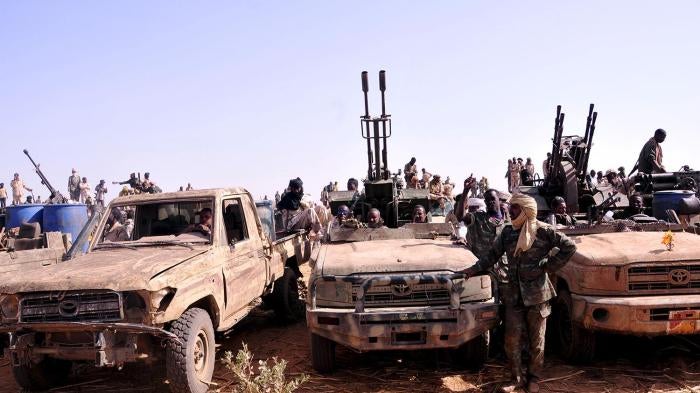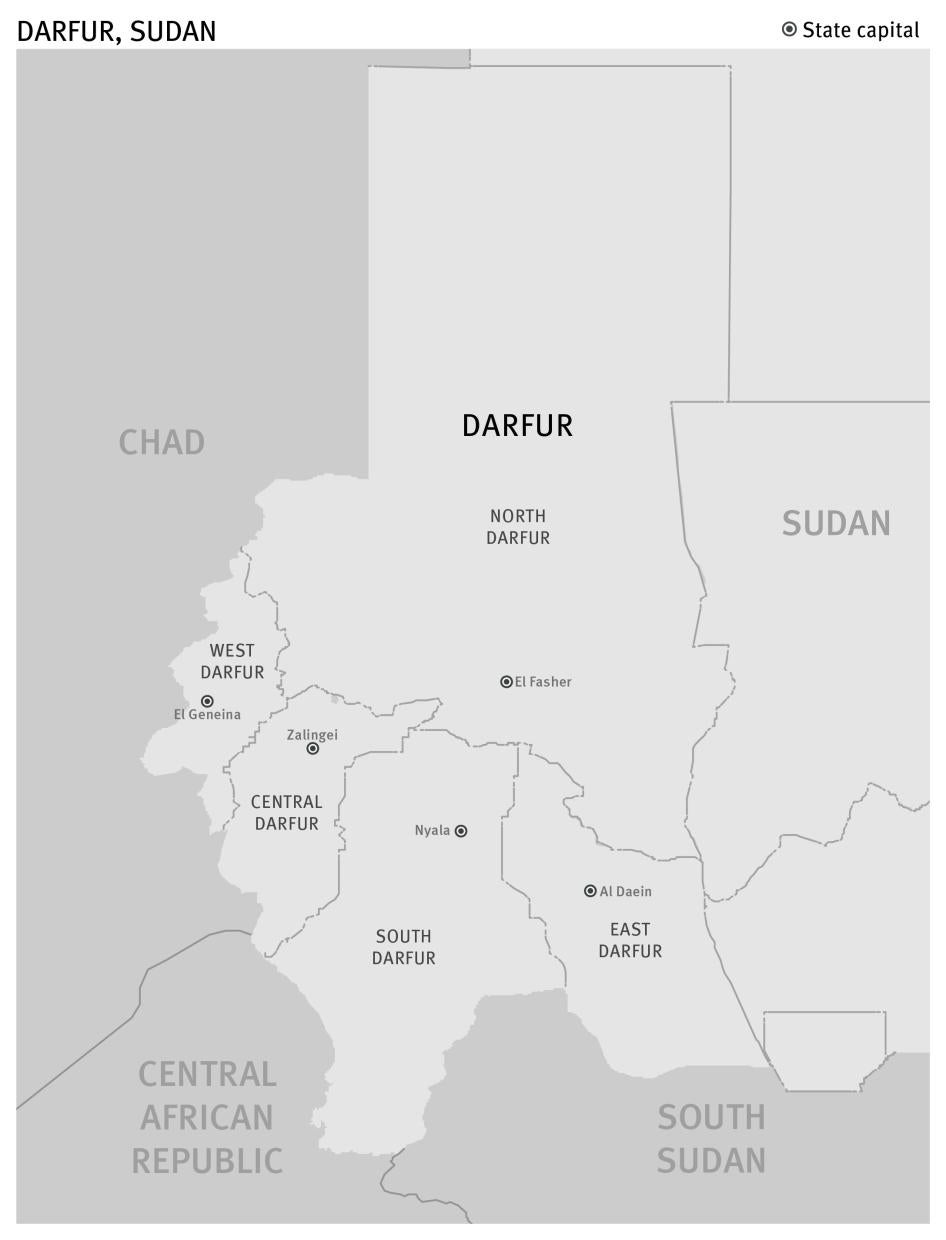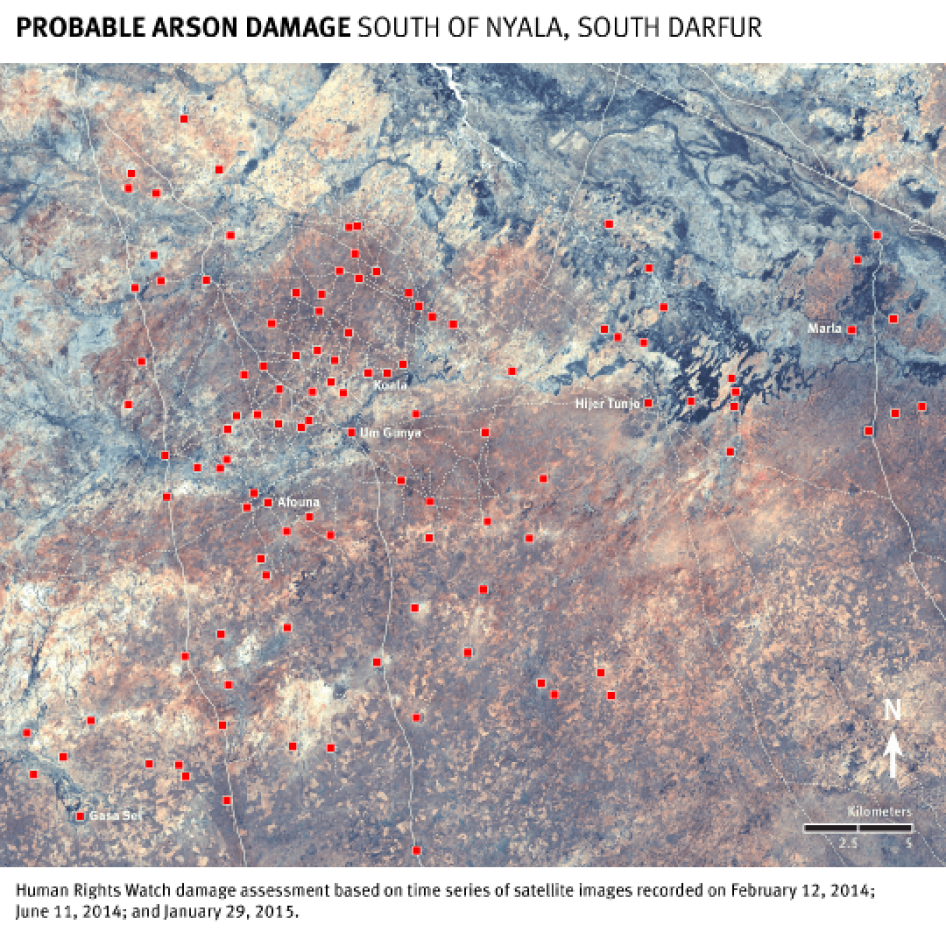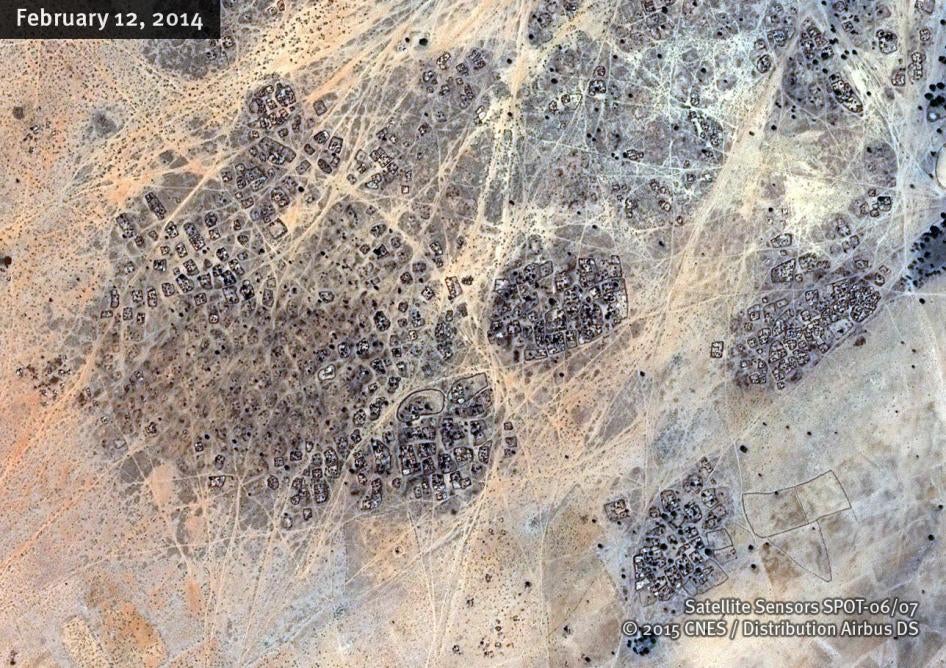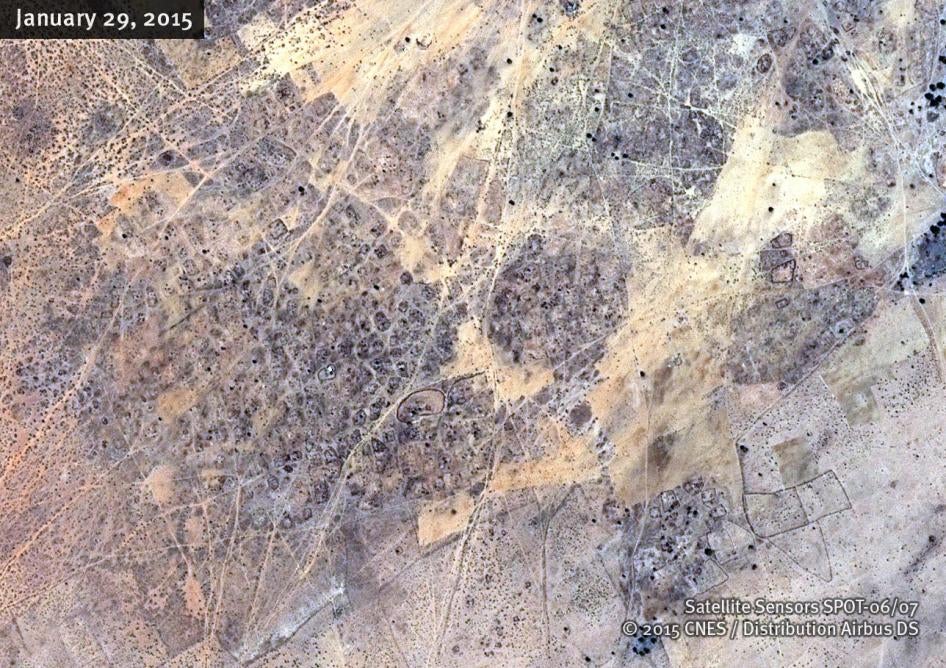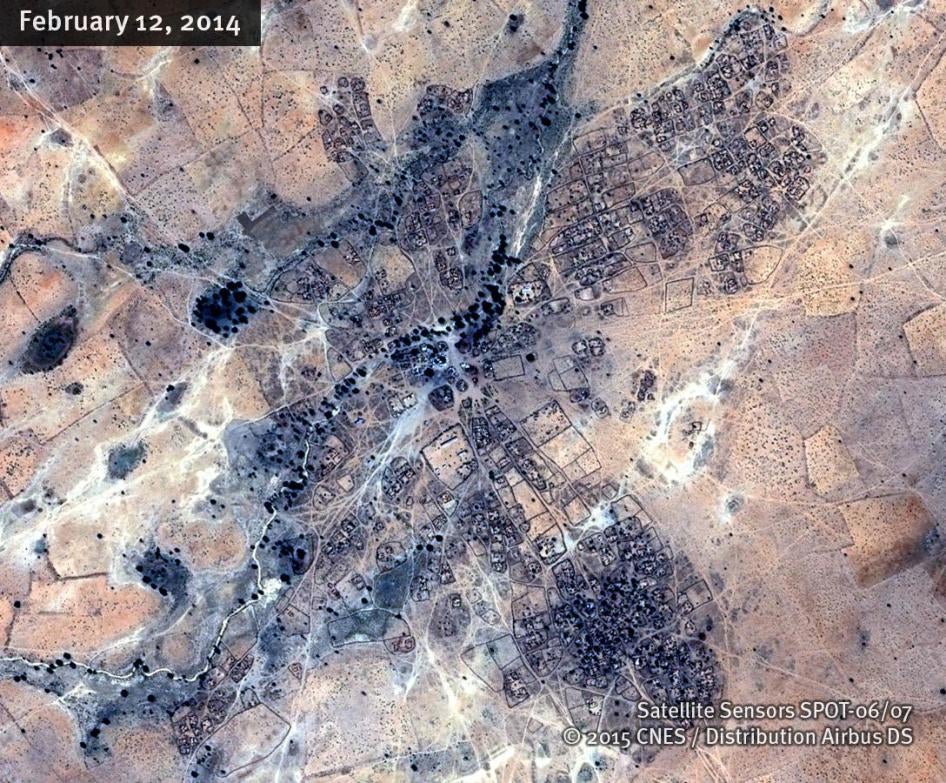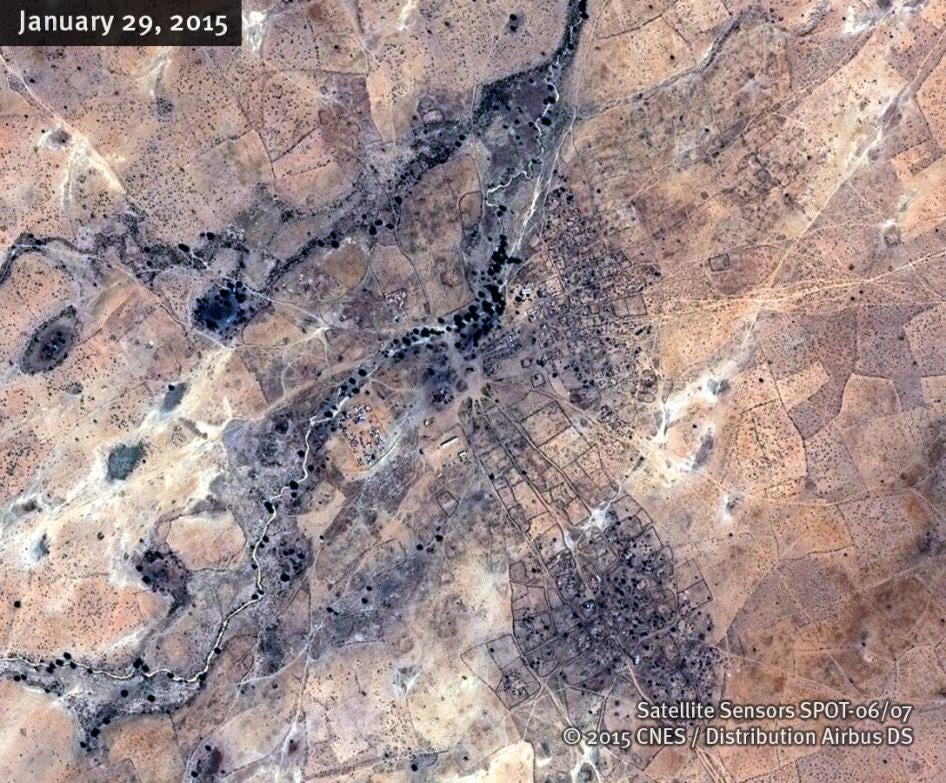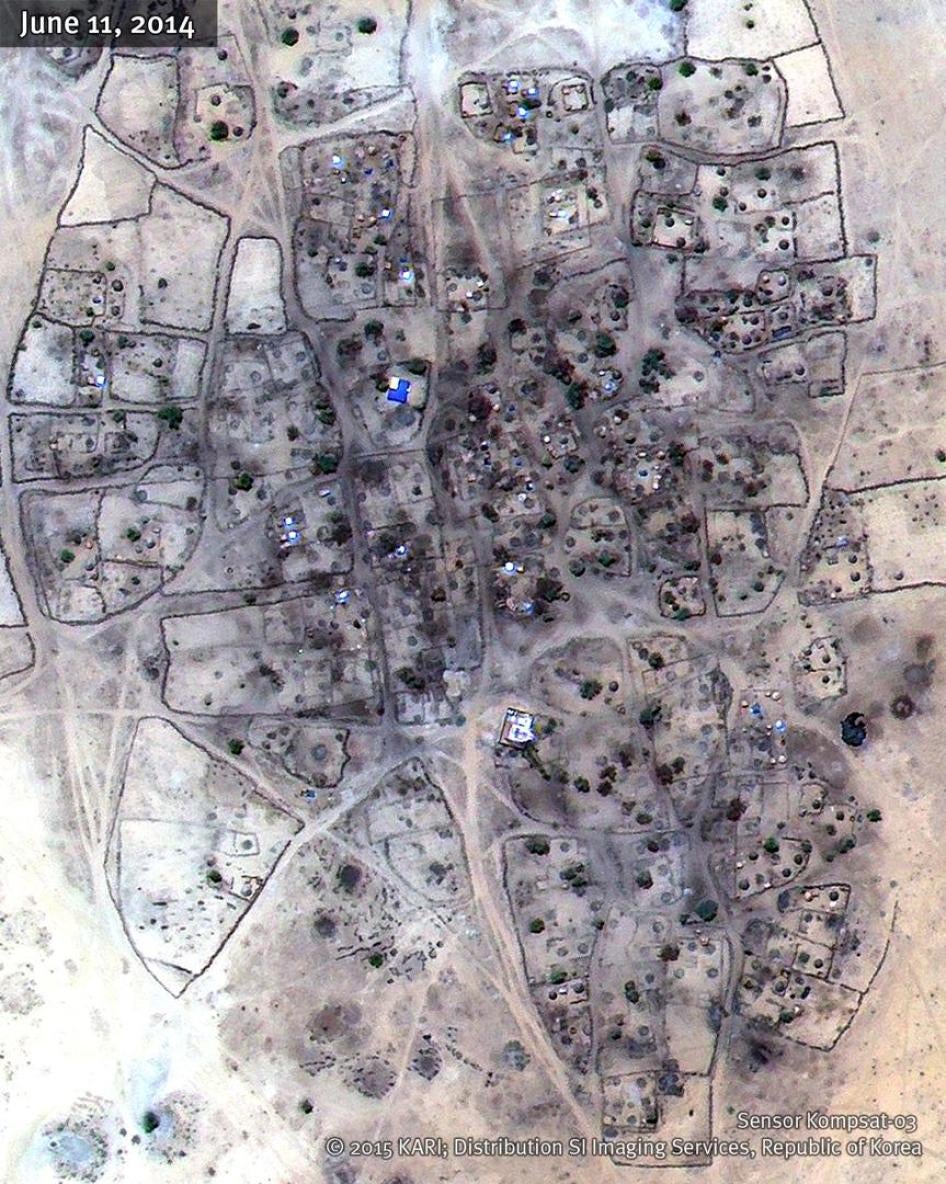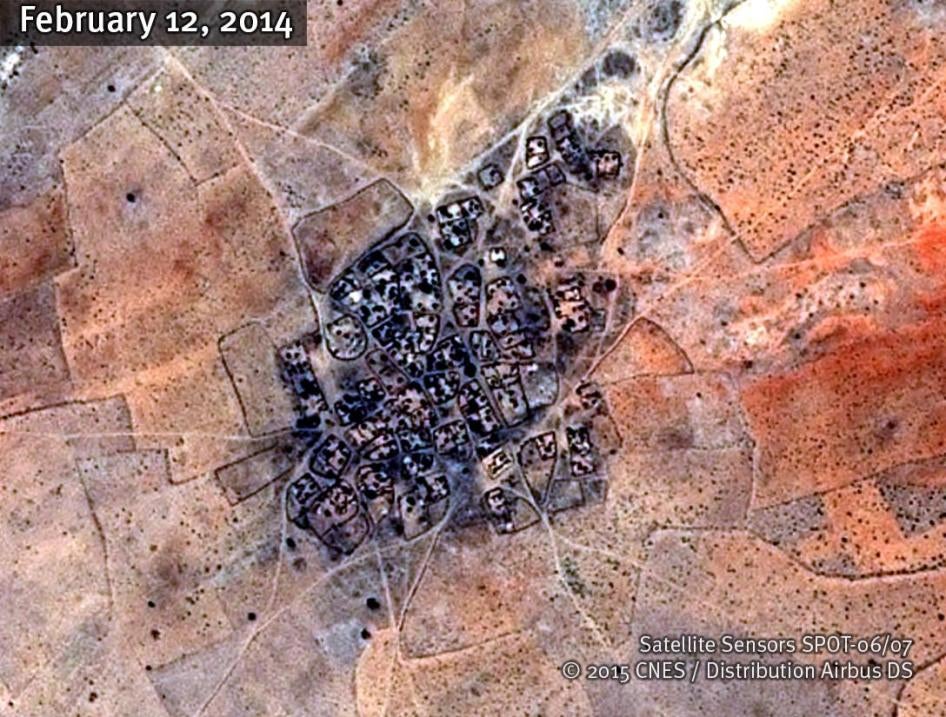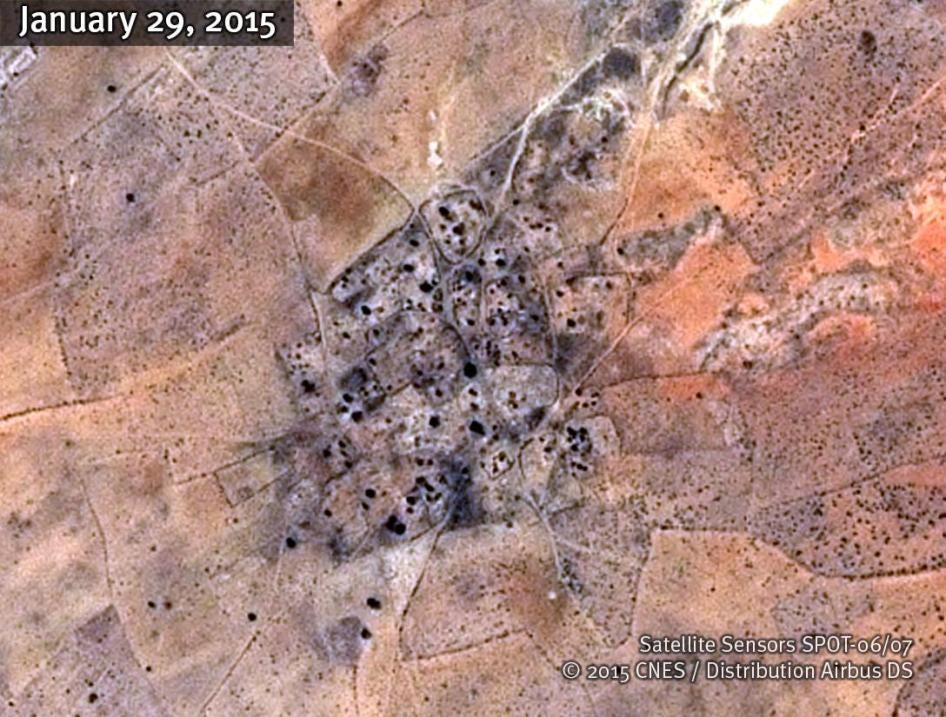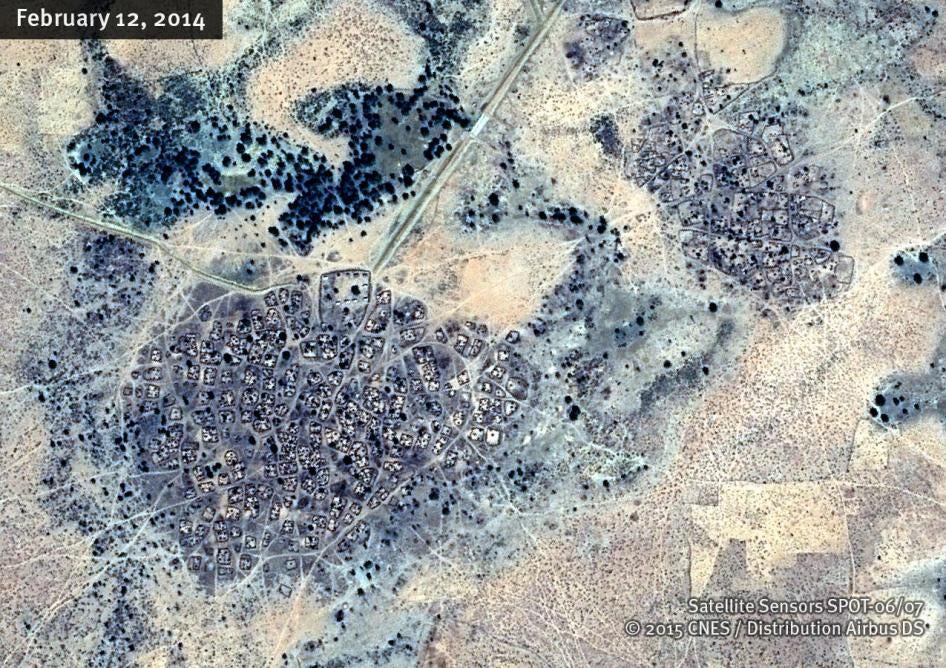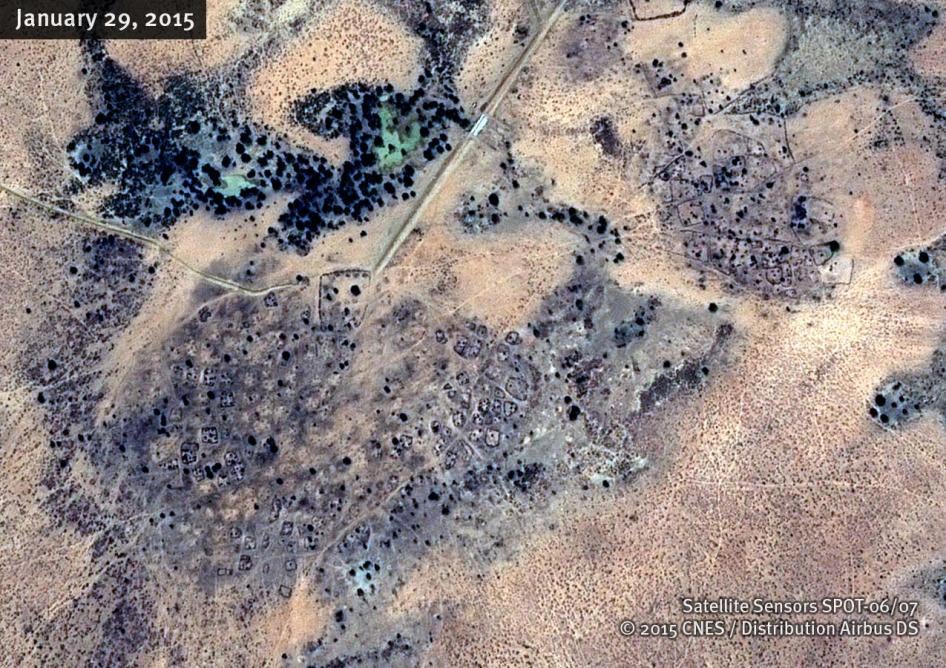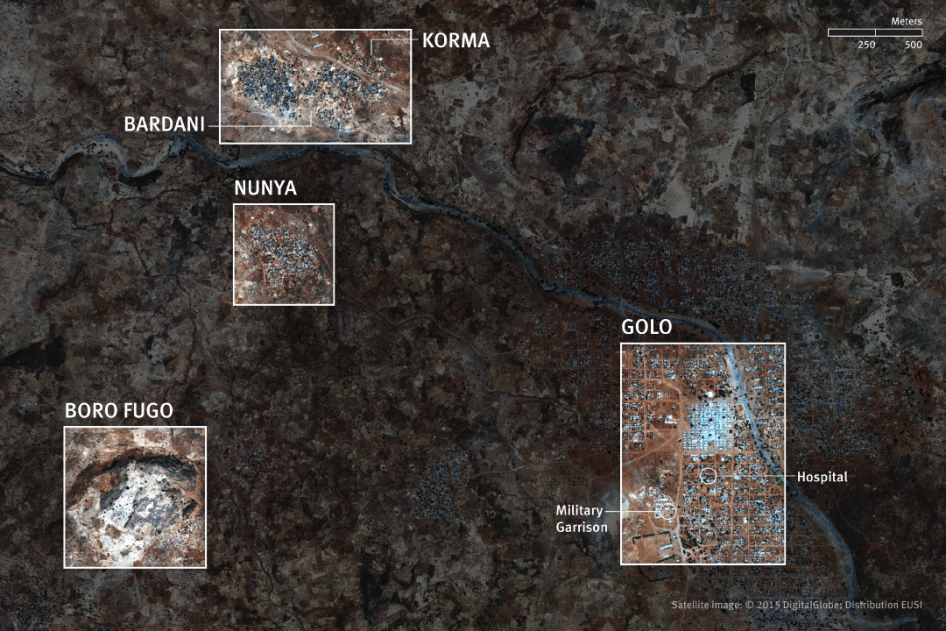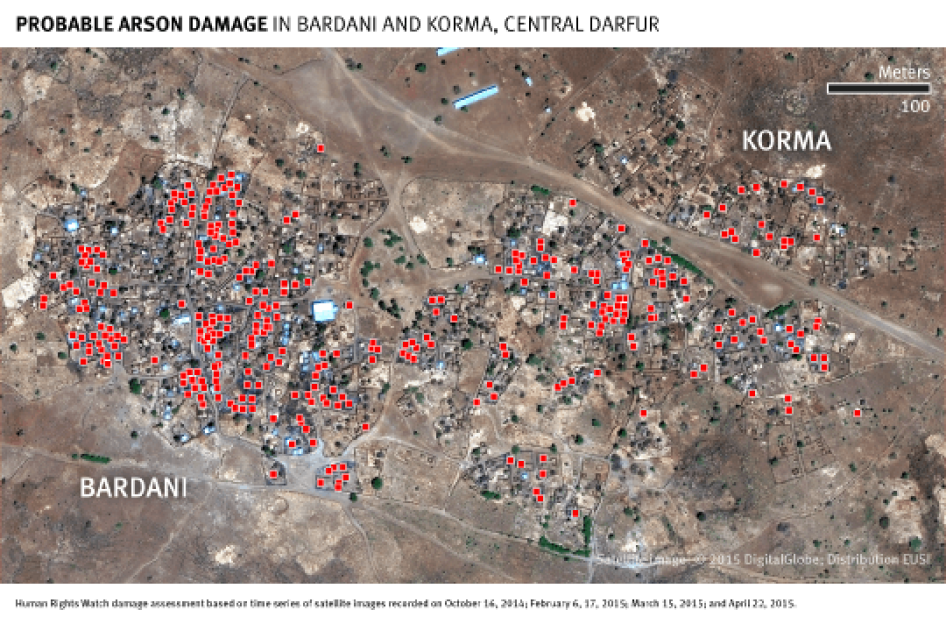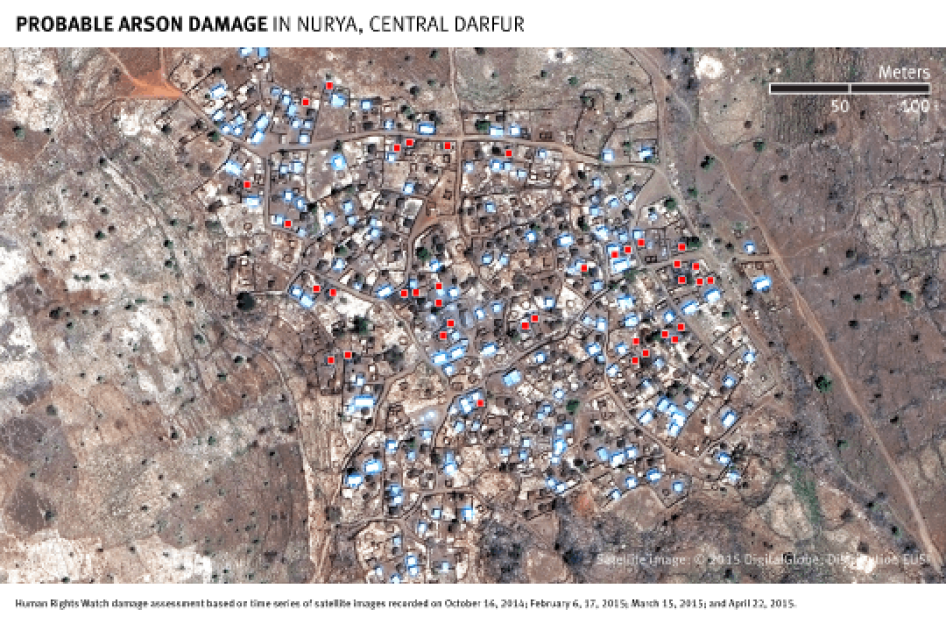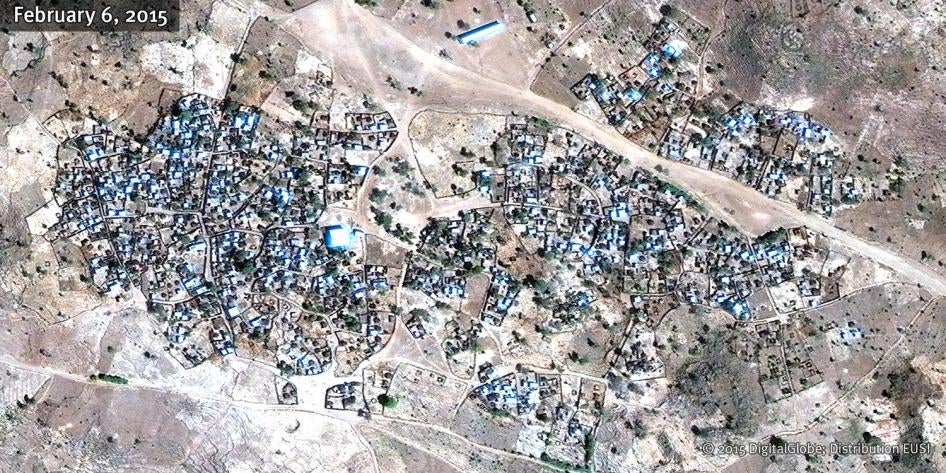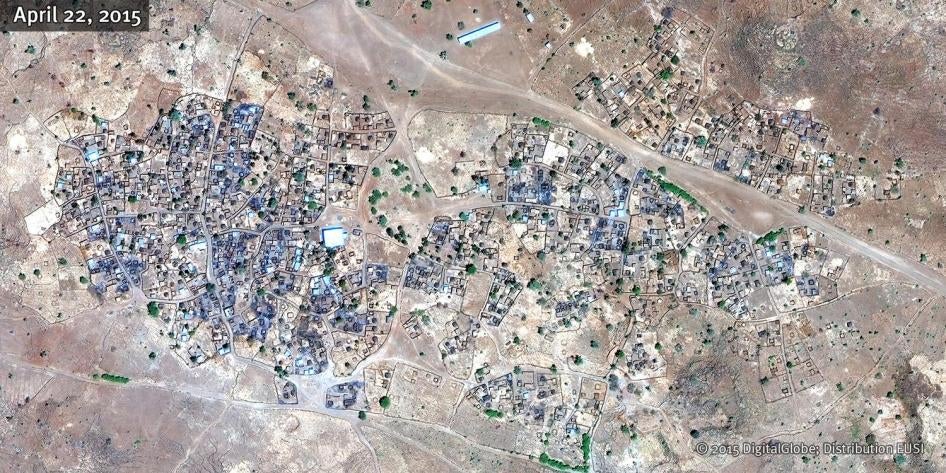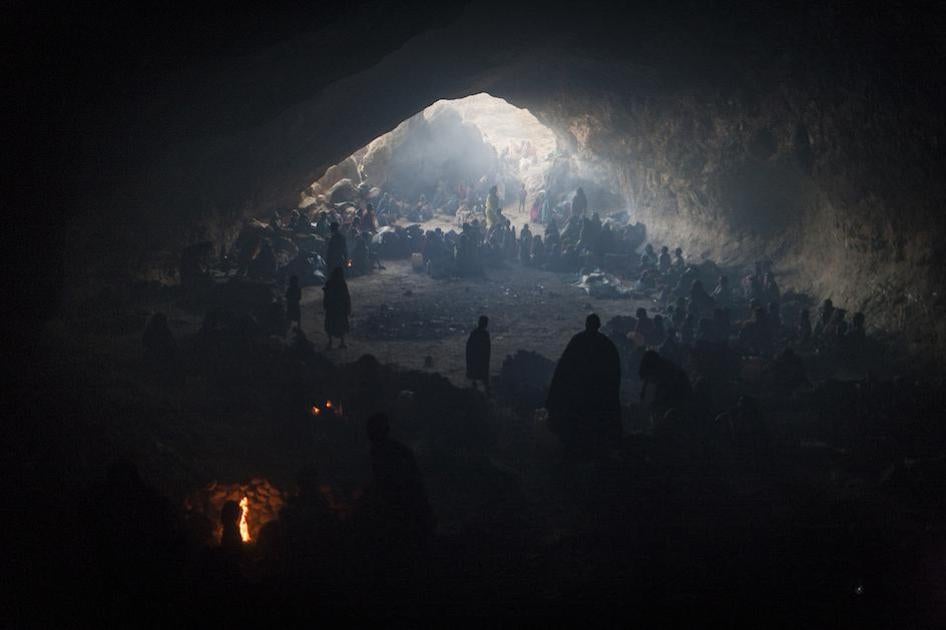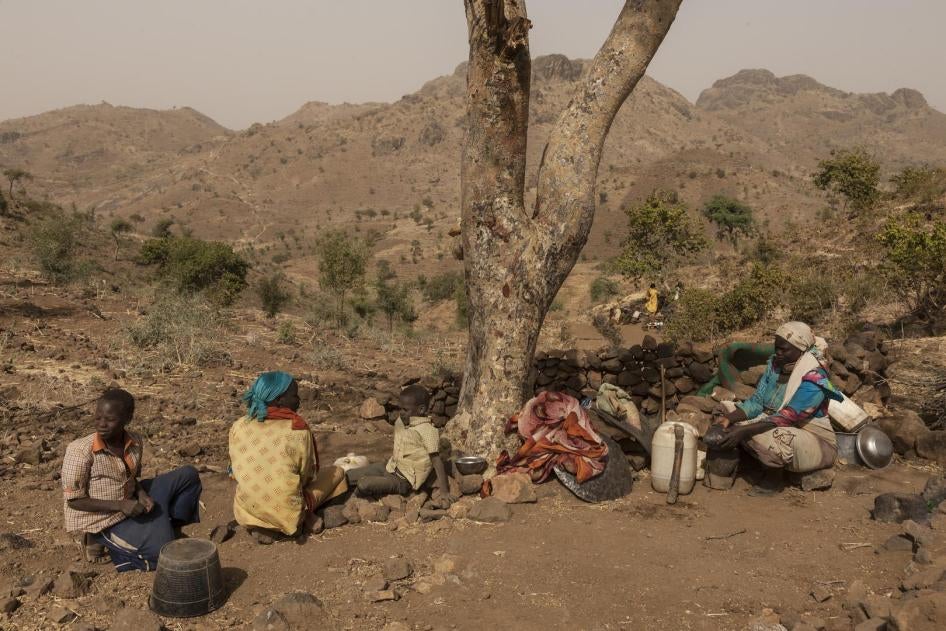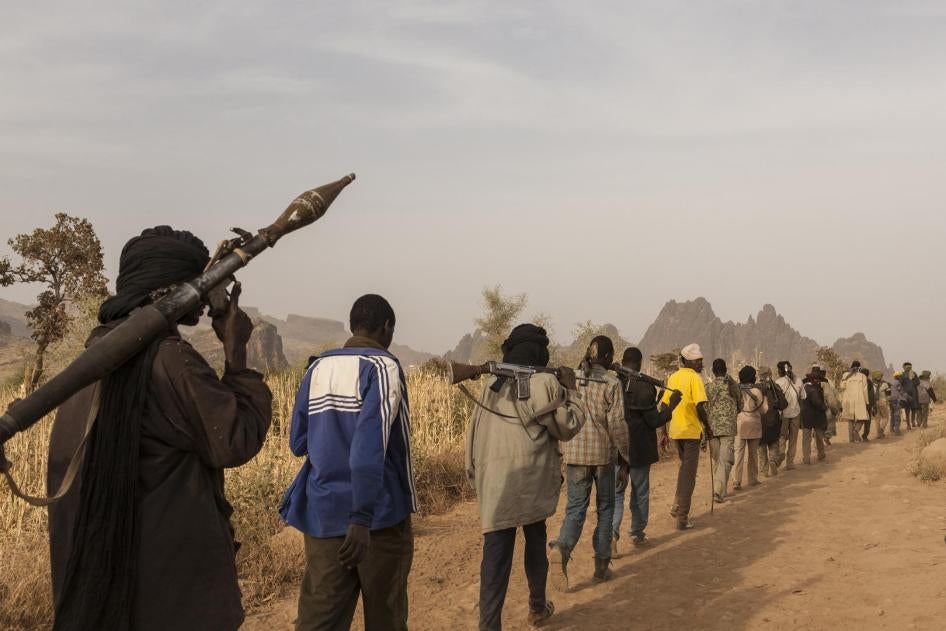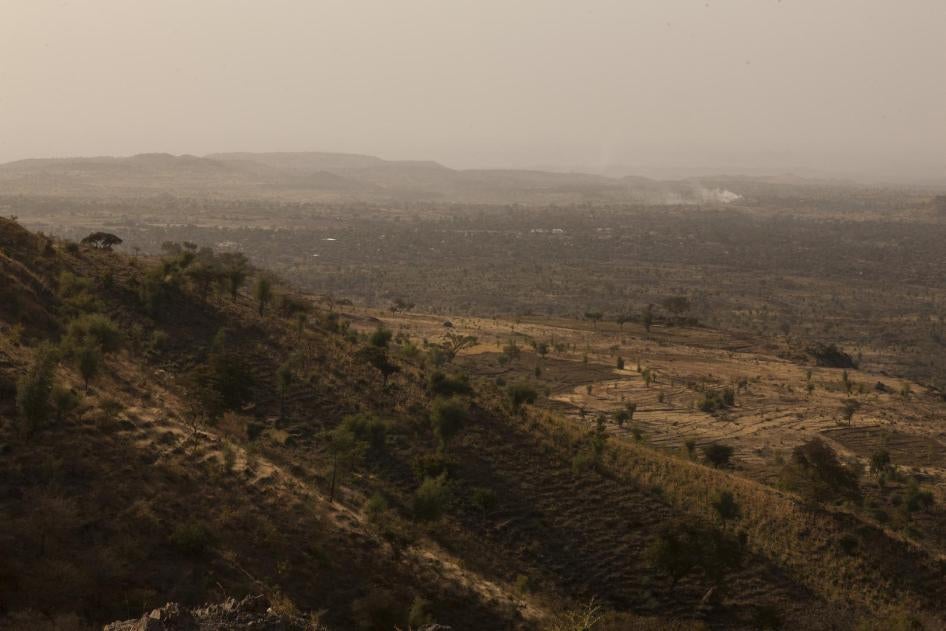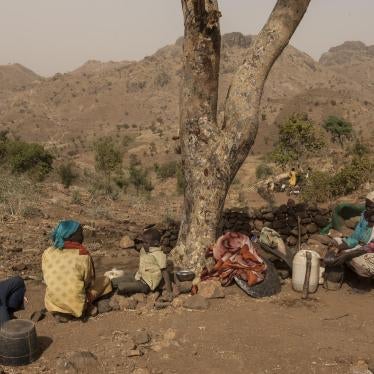Summary
“[The government soldiers] confiscated our belongings. They took our livestock. They beat the men. And then they raped us. They raped us in a group. Some women were raped by 8 or 10 men. Seventeen women were raped together. All of us were raped. Even the underage girls were raped.”
– Mahassan , 38, resident of the Golo area, July 2015
“I am deeply sorry. But you must understand that this was not my endeavor, I was under the command of men with no mercy. I wish I could turn back the time.”
– Ibrahim, 19, Sudanese military defector who admitted killing a young woman, July 2015
The Rapid Support Forces (al-Quwat al-Da’m al-Sari’ in Arabic, or RSF) is a Sudanese government force under the command of the National Intelligence and Security Services (NISS). The RSF was created in mid-2013 to militarily defeat rebel armed groups throughout Sudan.
The RSF led two counterinsurgency campaigns in the long-embattled region of Darfur in 2014 and 2015 in which its forces repeatedly attacked villages, burned and looted homes, beating, raping and executing villagers. The RSF received support in the air and on the ground from the Sudanese Armed Forces (SAF) and other government-backed militia groups, including a variety of proxy militias, commonly known as Janjaweed.
The first campaign named “Operation Decisive Summer” took place primarily in South Darfur and North Darfur between late February and early May 2014. The second, “Operation Decisive Summer II,” took place primarily in and around Jebel Marra, the mountainous region located primarily in Central Darfur, between early January 2015 and the onset of the rainy season in June 2015.
Based on research conducted between May 2014 and July 2015, this report describes serious violations of international human rights and humanitarian law perpetrated by the RSF and other Sudanese government forces during the two RSF-led counterinsurgency campaigns in Darfur. Human Rights Watch interviewed more than 151 survivors and witnesses of abuses in Darfur who fled Sudan to Chad and South Sudan, 16 who were interviewed inside Darfur, and an additional 45 victims and witnesses in Darfur by telephone.
Human Rights Watch found that the RSF committed a wide range of horrific abuses, including the forced displacement of entire communities; the destruction of wells, food stores and other infrastructure necessary for sustaining life in a harsh desert environment; and the plunder of the collective wealth of families, such as livestock. Among the most egregious abuses against civilians were torture, extrajudicial killings and mass rapes.
Many civilians were killed by the RSF when they refused to leave their homes or give up their livestock, or when they tried to stop RSF fighters from raping them or members of their family.
The RSF violations of international humanitarian law amount to war crimes. The mass rape and killings and other abuses appear part of widespread and systematic attacks on civilian populations that may constitute crimes against humanity. Crimes against humanity are serious offenses, including murder, torture and rape, committed as part of a widespread or systematic attack on a civilian population. As Human Rights Watch research has found, the RSF committed rape in numerous towns and villages over an extended period of time, making them widespread. First-hand accounts of orders from commanders to commit crimes and the RSF’s repeated use of abusive practices indicate that they were systematic.
The attack on the town of Golo, in central Jebel Marra, was emblematic of RSF atrocities. The Sudan Liberation Army/Abdul Wahid (SLA/AW) rebel faction had contested control of Golo at various times since the Darfur conflict began in 2003, but during the past year the town had been firmly under government control.
On January 24 and 25, 2015 the RSF took over the town, burning buildings and looting. Human Rights Watch interviewed 21 people who had been in Golo and neighboring villages at the time. Nearly everyone interviewed said that they witnessed killings, rape, and widespread beating and looting.
Nur al-Huda, a young woman from Golo, told Human Rights Watch that she was in her compound with her father and sisters when the RSF attacked: “They killed my father. My father was defending us so that we would not be raped and he was beaten to death. … After they killed my father they raped the three of us. Me and my two sisters. … After they raped us they stole everything.”
During the three weeks after they attacked Golo, the RSF continued to rape scores of women and girls in the town and many more in the neighboring village of Bardani. Many of the women were gang raped, often in front of community members who were forced to watch. Those who resisted were killed. The naked bodies of many dead women were later discovered in the streets; other women were burned alive. The survivors of the Golo mass rape have not had access to medical or psychosocial services.
Many survivors of RSF attacks fled to camps for internally displaced persons (IDPs) in government-controlled territory or the hills and mountains outside of government-controlled areas. Those who fled to IDP camps are almost entirely dependent on the international community for a modicum of protection and subsistence; survivors who fled to the hills, primarily in Jebel Marra and East Jebel Marra, are often unable to return to their farms with no access to desperately needed humanitarian assistance. Both groups remain vulnerable to further abuse.
The United Nations Organization for the Coordination of Humanitarian Affairs (OCHA) has received reports that as many as 130,000 people remain displaced in areas out of the reach of humanitarian agencies. Lacking adequate food, shelter, and medical care, and unable to return to their homes or their farms, there is a risk that they could face death from starvation, illness, or exposure to the elements. RSF attacks were often carried out in areas that had been controlled or contested by two of the most significant rebel factions, including the Sudan Liberation Army/Minni Minnawi (SLA/MM) in 2014 and the SLA/AW faction in 2015. However, the overwhelming majority of the abuses reported to Human Rights Watch were committed by RSF or other government forces in villages and towns where rebels were reportedly never present or had left prior to the attacks. Some RSF attacks even occurred in towns or villages that were entirely under government control.
Human Rights Watch also spoke with five defectors from Sudanese government forces: two RSF members, two SAF soldiers, and one Border Guard. Four of the defectors participated in attacks in Jebel Marra or East Jebel Marra. All five defected to the rebels after having participated in RSF-led counterinsurgency campaigns, during which time they witnessed serious abuses by soldiers. Four of the five said commanding officers ordered their units to carry out atrocities against civilians. One admitted to committing serious crimes himself.
The numerous abuses documented in this report demonstrate the continuing need for an effective and rapidly responsive international force that can help protect civilian populations in Darfur from attack. The abuses also demonstrate that the current African-Union-United-Nations Hybrid Operation in Darfur, UNAMID, has been hamstrung in its performance and in the implementation of its core mandate to protect civilians.
The UN and AU should focus on how to urgently improve and bolster UNAMID’s ability to protect civilians from attacks, including the kinds of attacks they have suffered during the RSF-led campaigns, and to effectively investigate and expose abuses without endangering victims and witnesses.
Although UNAMID’s mandate includes reporting on human rights abuses, the mission has failed to release any detailed documentation about abuses against civilians during either of the RSF-led counterinsurgency campaigns. Several reports of the UN secretary-general to the UN Security Council have referred to attacks by the RSF causing civilian displacement; however, there has been no indication of magnitude of the other serious abuses, such as sexual violence, extrajudicial killings, and burning of villages.
Human Rights Watch calls on the UN Security Council, the AU Peace and Security Council, and UNAMID to take concrete steps to protect civilians in Darfur from further abuse, including sanctioning individuals responsible for attacks on civilians, to expand and ensure access to humanitarian assistance for victims, including medical and psychosocial care for victims of sexual violence and other forms of trauma, and to press for cooperation with the International Criminal Court’s investigation and prosecution of grave international crimes in Darfur.
Satellite Imagery Analysis
Hijer Tunjo
Recommendations
To the Government of Sudan
- Immediately disarm and disband the Rapid Support Forces and withdraw them from Darfur.
- Immediately issue clear, public orders to all government forces in Darfur to stop all attacks against civilians.
- Immediately allow UNAMID, independent and impartial humanitarian agencies, and human rights organizations unfettered access to all areas of Darfur.
- Conduct prompt, impartial and independent investigations of abuses by the Rapid Support Forces and other government forces in Darfur and prosecute alleged perpetrators in accordance with international fair trial standards.
- Promptly provide redress to the victims of abuses by government forces, including through compensation and recovering and returning all looted property.
- Ensure the urgent provision of comprehensive and non-discriminatory health services to women and girls who have experienced sexual violence. Ensure that male survivors of sexual violence also have access to these services.
- Cooperate fully with the International Criminal Court, including in the execution of arrest warrants.
To the African Union-United Nations Hybrid Operation in Darfur (UNAMID)
- Publicly demand access to Jebel Marra and other areas in Darfur where civilians are vulnerable to serious abuse and establish a permanent presence in these areas, such as an operating base, and implement proactive patrols to help protect civilians.
- Investigate and publicly report allegations of serious abuses by the Sudanese security forces, including the Sudanese Armed Forces, the Rapid Support Forces, pro-government militias and opposition armed groups. If access to the locations where the alleged abuses took place is not granted, UNAMID human rights officers should investigate through telecommunication and other remote research methods.
To the United Nations Security Council and the African Union Peace and Security Council
- Demand that Sudan allow UNAMID immediate and unrestricted access to all of Darfur, including to establish a permanent presence, such as an operating base, in government-controlled, rebel-controlled, and contested areas where it now has little or no presence.
- Impose travel bans and asset freezes on individuals responsible for the attacks on civilians in Darfur, and for the continued obstruction of peacekeepers and UN investigators.
- Press for cooperation by the Sudanese government with the International Criminal Court’s investigation and prosecution of serious international crimes committed in Darfur.
To the European Union and Member States
- Send a clear message to the government of Sudan that continued crimes in violation of international law, impunity for such crimes, and repeated failure to cooperate with the International Criminal Court (ICC), will result in the imposition of targeted punitive EU sanctions against individuals and entities deemed responsible, as ministers warned in their General Affairs and External Relations Council meeting conclusion on Sudan in June 2008. EU member states should task the EU High Representative with drawing up a list of individuals and entities who could be subject to such sanctions.
- If there is a lack of progress in ending the abuses and impunity, the EU Foreign Affairs Council should adopt targeted punitive sanctions, including travel bans and asset freezes against individuals and entities, on all sides of the conflict, found to be responsible 1) for serious violations of the laws of war, 2) for continued impunity for grave international crimes, or 3) for Sudan’s failure to meet its Chapter VII obligations under the UN Charter and cooperate with the ICC.
To the UN Office of the High Commissioner for Human Rights
- The Office of the High Commissioner for Human Rights should rectify UNAMID’s past failure to investigate mass rape by promptly dispatching a special investigative team with expertise in sexual and gender-based violence to conduct an investigation into alleged rape and other sexual violence in Darfur. If independent access to the affected areas is not granted, the team should investigate through interviews outside of Darfur and other remote research methods.
To the UN Human Rights Council and the Independent Expert on Sudan
- The Human Rights Council should request the Office of the High Commissioner for Human Rights to urgently dispatch an investigative team with expertise in sexual and gender-based violence to conduct an investigation into alleged abuses in Darfur.
- The Independent Expert on the situation in Sudan should urgently request access to areas affected by serious abuses committed by the Rapid Support Forces and other government forces in Darfur and report the findings and recommendations to the UN Human Rights Council.
To Opposition Armed Groups
- Reestablish humanitarian coordinators and develop a strategy to encourage humanitarian agencies back to rebel-controlled areas.
- Facilitate the full, safe and unimpeded access of humanitarian personnel and the urgent delivery of humanitarian assistance to all civilians living in and around rebel-controlled territory.
To the AU Special Envoy on Women, Peace and Security, the AU Commission on Human and Peoples’ Rights, the UN Special Rapporteur on Violence against Women, and the UN Special Representative of the Secretary-General on Sexual Violence in Conflict
- Encourage UN bodies and humanitarian aid agencies to take steps to ensure victims of sexual abuse, Golo, and other areas of Darfur have access to comprehensive and non-discriminatory health services.
Methodology
The research for this report was conducted between May 2014 and June 2015. Human Rights Watch interviewed a total of 212 victims and witnesses of the Darfur attacks including 151 who fled Sudan to Chad and South Sudan and 16 who were interviewed inside Darfur. Forty five interviews were conducted by telephone from outside Sudan.
Almost all interviews were conducted individually and generally lasted between 45 and 90 minutes. The interviewees included 178 men, 30 women and 4 children. Human Rights Watch also interviewed five soldiers who defected from government forces after participating in attacks described in this report.
We also interviewed numerous humanitarian workers, national and international UNAMID staff, local and international journalists, Sudanese civil society activists, and traditional leaders from Darfur. More than two dozen members of Darfur rebel groups were interviewed. Five former members of Sudanese government security forces were interviewed.
Several intermediaries in Darfur helped to identify and contact interviewees.
All interviews were conducted in Arabic or with the assistance of interpreters who were fluent in English, Arabic, and at least one other local language. Interviewees were fully informed about the nature and purpose of the research and how the information they provided would be used. Human Rights Watch obtained oral consent for each of the interviews. No incentives were provided to individuals in exchange for their accounts.
Those interviewed by telephone from inside Darfur described a continuing climate of fear. Many interviewees told Human Rights Watch that they were afraid of reprisals from government authorities if they were identified as having spoken to Human Rights Watch. As a result, many names, precise ages, neighborhoods, and other identifying details have been withheld in this report to protect their security. Names have been replaced with pseudonyms.
On August 12, 2015, Human Rights Watch sent a letter to the Permanent Representative of Sudan to the United Nations, outlining the major findings in the report and requesting a written response to several questions related to the findings. A written response has not been provided; however, on September 2, Human Rights Watch met Ambassador Omer Dahab F. Mohammed, of Sudan’s mission to the UN, to discuss the report’s major findings.
I. Background
Since 2003 an armed conflict between the government of Sudan and rebel groups has ravaged Sudan’s western region of Darfur.
Darfur’s civilian population has suffered enormously throughout the conflict. The United Nations (UN) estimates that over 300,000 people have been killed by violence or conflict-induced disease, starvation, or dehydration.[1] Thousands of villages and countless livelihoods have been destroyed.[2] Sexual violence against women and girls has been widespread.[3]
According to UN estimates, 4.4 million people in Darfur are in need of humanitarian assistance.[4] Some 2.9 million people displaced by the conflict face enduring hardships inside Darfur or in refugee camps in eastern Chad.[5] About 600,000 people were displaced during 2014 and the first five months of 2015.[6] Survivors of sexual violence have had little or no access to services.
The UN and the African Union (AU) have responded to the conflict with various interventions designed to resolve the conflict or to diminish the suffering experienced by the civilian population. The government and some rebel groups signed peace agreements in 2006 and 2011, both endorsed by the UN and the AU.[7] Neither agreement has significantly improved the security situation in Darfur.
In March 2005, the UN Security Council referred the situation in Darfur to the International Criminal Court (ICC), and three months later the ICC began its investigations.[8] The ICC has since issued arrest warrants for five individuals for serious crimes in violation of international law committed in Darfur. These include two warrants for Sudanese President Omar al-Bashir on charges of war crimes, crimes against humanity, and genocide.[9] Sudan has not cooperated with the court and all five remain at large.[10]
In May 2004, the government of Sudan, after severely limiting humanitarian operations during the first year of the conflict, began to permit UN agencies and international nongovernmental organizations (NGOs) increased access to Darfur, and soon, it became the world’s largest humanitarian operation. In March 2009, in response to the ICC arrest warrant issued for President al-Bashir, Sudan expelled 13 international NGOs and shut down three national NGOs.[11] These organizations included nearly all of the humanitarian agencies operating in the Jebel Marra area in Central Darfur. There has been very little meaningful humanitarian access to Jebel Marra or East Jebel Marra since the expulsions.[12]
In May 2014, the UN Organization for the Coordination of Humanitarian Affairs (OCHA) stated that, “Humanitarian organizations have so far been unable to confirm reports of close to 100,000 [people] displaced in and around the Jebel Marra area, where the heaviest fighting is understood to be taking place, due to continuing denial of access.”[13]
International peacekeepers have been present in Darfur since 2004. On July 31, 2007, the Security Council authorized the hybrid African Union-United Nations Mission in Darfur (UNAMID), which currently has approximately 16,000 peacekeepers deployed across the region.[14] UNAMID is mandated to “contribute to the protection of civilians populations under imminent threat of physical violence and prevent attacks against civilians,” including through the use of force, and to “contribute to the promotion of respect for and protection of human rights and fundamental freedoms in Darfur” through investigating, documenting, and reporting publicly on human rights abuses.[15]
In November 2014, Sudanese authorities shut down UNAMID’s human rights office in Khartoum, Sudan’s capital.[16] The government subsequently renewed calls for the mission to withdraw and on December 25, 2014 announced the expulsion of the two most senior UN officials in the country.[17] On June 29, 2015, the Security Council renewed the mission’s mandate for an additional year.[18] Since 2007, 216 UNAMID peacekeepers and other staff have been killed during the mission.[19]
Despite a 2008 agreement between the Sudanese government and UNAMID that gives the mission unfettered access to the whole of Darfur, the government routinely blocks peacekeepers from going to conflict-affected areas.[20] Peacekeepers have not been allowed meaningful access to the embattled Jebel Marra area in Central Darfur for five years. These denials of access, and frequent attacks by gunmen on peacekeepers, have severely hampered the mission’s effectiveness in protecting civilians and reporting on human rights abuses. For example, denial of access has obstructed a thorough investigation of a mass rape in the town of Tabit, North Darfur in 2014.[21] Human Rights Watch and journalists have raised concerns about the mission’s failure to protect civilians and report on human rights abuses, as well as UNAMID cover-ups and misreporting of the human rights situation.[22]
Apart from UNAMID, the UN Panel of Experts on Sudan, established in 2005, is mandated to report on violations of international human rights and humanitarian law. However, its reports are often not made public and the government of Sudan has severely restricted its access to Darfur.[23]
Military Forces
Sudanese Government Forces
The regular Sudanese military force is the Sudan Armed Forces (SAF). Throughout the conflict, the government of Sudan has also utilized several paramilitary forces including the Borders Guards, the Central Reserve Police, and the Popular Defense Forces (PDF) as well as a variety of proxy militias, commonly known as the “Janjaweed.” Military, paramilitary, and militia groups have often fought together against rebels and in attacks against the civilian population.
Rapid Support Forces
The Rapid Support Forces (RSF), al-Quwat al-Da’m al-Sari’ in Arabic, are a Sudanese government force under the command of the National Intelligence and Security Services (NISS).[24] The RSF was created in mid-2013 specifically to fight against rebel groups throughout Sudan.
Members of the RSF have been issued NISS identity cards.[25] These IDs ensure them immunity under the National Security Services Act of 2010.[26] In January 2014, a constitutional amendment gave NISS and the RSF “regular force” status.[27]
The force is commanded on the ground by Brig. Gen. Mohammed Hamdan Dagolo, commonly known as “Hemeti.” Hemeti is a former Border Guard commander and Janjaweed militia leader. He is the nephew of Juma Dongolo, the traditional chief of the Awlad Mansour section of the Mahariya clan of abbala (camel-herding) Riziegat Arabs.[28] Hemeti reports to the NISS Maj. Gen. Abbas Abdul-Aziz, who is based in Khartoum.[29]
Overall command is said to reside with NISS Director General Al al-Nasih-Al-Galla.[30]
The members of the RSF have been drawn from paramilitary forces, notably the Border Guards, and other government-backed militia groups, including a variety of proxy militias, commonly known as Janjaweed.[31] According to several sources, including General Abdul-Aziz, the majority of RSF members are Darfurians recruited by Hemeti.[32] Many of the Darfurians come from Hemeti’s clan and other clans within the abbala Riziegat; however, they also come from other ethnic groups in Darfur. Ethnic Nuba have also reportedly been recruited into the RSF. Civilians who have heard members of the RSF speaking claim that some of the fighters speak foreign dialects of Arabic, which they believe to be Chadian and Nigerien.[33]
The RSF is reported to be better equipped than other paramilitary and militia groups in Sudan. At the time of their arrival in Darfur in February 2014, the RSF was reported to consist of 5,000 to 6,000 troops with 600 to 750 vehicles.[34] However, this number is widely believed to have grown during the past year.
The RSF have received Sudanese Armed Forces aerial support and have fought alongside the army and other paramilitary and militia groups. However, in some instances, including one documented by Human Rights Watch in this report, RSF soldiers have fought against the armed forces.[35]
The RSF has carried out two counterinsurgency campaigns in Darfur since February 2014 during which the forces repeatedly attacked villages, burned and looted homes, raped and beat villagers, and executed civilians.
Initially deployed to South Kordofan in southern Sudan, the RSF arrived in Darfur on February 19, 2014. Major operations began in South Darfur, in the area south of the railway that runs between Nyala, the capital of South Darfur, and Al Daein, the capital of East Darfur. RSF Major General Abdul-Aziz stated publicly that the RSF entered Darfur for the purpose of defeating the rebels.[36]
The SLA/MM fighters who had controlled or at least been based in the area largely fled either prior to or shortly after the arrival of the RSF. After attacking numerous villages, the RSF redeployed to North Darfur where the force conducted operations throughout March and April before returning to Khartoum in May.[37]
In May 2014 the NISS arrested two prominent opposition figures, former prime minister Sadiq al-Mahdi and the head of the Sudanese Congress Party, Ibrahim al-Sheikh, and charged them with libel for criticizing the human rights record of the RSF. [38] Al-Madhi was released one month later; Ibrahim al-Sheikh was not released until September, 2014.[39]
On December 23, 2014, President al-Bashir announced the recommencement of RSF operations in Darfur. Bashir stated that the aim of the campaign was to eliminate the rebel movement in Darfur and other areas of Sudan.[40] Shortly after Bashir’s announcement, the RSF commenced military operations in Jebel Marra and East Jebel Marra. In April 2015, the RSF captured 100-150 vehicles from the JEM in Goz Dango, South Darfur, and pushed the rebel group out of Darfur into neigboring South Sudan.[41]
Rebel Armed Groups
Throughout most of the Darfur conflict, the three largest rebel factions have been the Sudan Liberation Army faction led by Abdul Wahid Mohammed Ahmed el-Nur (SLA/AW), the Sudan Liberation Army faction led by Minni Arko Minnawi (SLA/MM), and the Justice and Equality Movement led by Gibril Ibrahim (JEM).
Rebel fighters have come primarily from three ethnic groups: the Zaghawa, the Fur, and the Massalit; however, many other tribes are also represented, including some members of Arab tribes. Beginning in 2006, perhaps earlier, the three factions began splintering into dozens of smaller groups, often divided along ethnic lines.[42]
In 2012, the SLA/AW, SLA/MM, and the JEM entered into a coalition with the Sudan Peoples’ Liberation Movement-North (SPLM-N), a rebel movement operating in South Kordofan and Blue Nile states, called the Sudan Revolutionary Front (SRF).
The size of the areas controlled by rebel groups, and the degree of control, has varied significantly throughout the conflict. In 2015, the rebel movements appear to control less territory than at any point since the start of the conflict. The SLA/MM is now reduced to isolated pockets in rural North Darfur, with the SLA/AW controlling rural areas in Jebel Marra and East Jebel Marra.[43] The JEM, which has long claimed that its objectives are national and not to hold territory in Darfur, controls virtually no territory.[44]
Fighting in Darfur since 2014
Besides attacks by the RSF and other government forces on civilians causing massive displacement, described below, there has been other fighting in Darfur since 2014.[45]
Government forces and rebel groups, particularly the SLA/AW in Jebel Marra and the SLA/MM in North and South Darfur, have continued to engage in armed conflict throughout this period.[46] There has also been some infighting within the SLA/AW.[47]
At various points during the past two years, certain militias, including those controlled by Janjaweed commander Musa Hilal, whose forces have long been implicated in serious abuses in Darfur, have been in open rebellion against the government. These rebellions have contributed to the large-scale displacement of civilians.[48]
Moreover, intercommunal fighting between Arab communities and between Arab and non-Arab communities, a prominent feature of the conflict since 2006, has intensified during the past two years.[49] These conflicts are driven by control over natural resources, especially gold and land for agriculture, and political power.[50] They have caused numerous casualties and large-scale displacement. These so-called “tribal” conflicts are often described by Sudan and by international actors, including UNAMID, as occurring independently of any government involvement; however, there is considerable evidence, including witness accounts, that the government plays an important and often decisive role by supporting and arming specific groups for its own political benefit.
II. Rapid Support Forces Attacks on Civilians since 2014
The RSF’s first counterinsurgency campaign in Darfur, called “Operation Decisive Summer,” took place primarily in South Darfur and North Darfur and was carried out between late February and early May 2014. The second campaign, “Operation Decisive Summer II,” has been conducted primarily in Jebel Marra and East Jebel Marra; it began in early January 2015 and major operations appear to have ceased by the onset of the rainy season in in June 2015. During both campaigns the RSF received Sudanese government air support and often fought with Sudanese military forces as well as other paramilitary and militia forces.
Human Rights Watch has documented during both operations apparent crimes against humanity – that is, widespread and systematic abuses by the RSF that are part of an attack against a civilian population. The abuses include killings, mass rape and torture of civilians; the forced displacement of entire communities; the destruction of the physical infrastructure necessary for sustaining life in the harsh desert environment including wells, food stores, shelter, and farming implements; and the plunder of the collective wealth of families, mainly livestock.
The RSF frequently killed civilians who challenged the RSF abuses: those who refused to leave their homes, refused to give up their livestock, or resisted being raped or attempted to defend their family members from being raped.
Many survivors of RSF attacks fled to displaced camps for internally displaced persons (IDPs) in government-controlled territory or the hills and mountains outside of government-controlled areas. Those who fled to IDP camps are almost entirely dependent on the international community for a modicum of protection and subsistence; survivors who fled to the hills, primarily in Jebel Marra and East Jebel Marra, are often unable to return to their farms with no access to desperately needed humanitarian assistance. Both groups remain vulnerable to further attacks by government forces.
“Operation Decisive Summer,” Phase I, February-May 2014
Between February and May 2014, the RSF attacked communities throughout South Darfur and North Darfur. The magnitude of the laws of war and human rights violations during this time has yet to be comprehensively documented.
The UN Panel of Experts on Sudan gathered information indicating that more than 103 villages had been destroyed by RSF attacks in North and South Darfur between February 28 and April 29, 2014.[51]
Victims, witnesses, traditional leaders, and local human rights investigators provided Human Rights Watch with the names of scores of villages and hamlets destroyed by the RSF in South Darfur and North Darfur between February and April 2014.
Attacks in South Darfur: February 27 to early March 2014
Between February 11 and 19, 2014, several thousand RSF troops under the command of General Hemeti arrived in East Darfur from North Kordofan.[52] During the following week they deployed in different locations in the area south of the railway that runs between Nyala, the capital of South Darfur State, and Ed Daein, the capital of East Darfur State.
Beginning on February 27, the RSF, often with Sudanese air support, attacked and burned a large number of undefended villages throughout South Darfur. The RSF attacked the towns Hijer Tunjo, Um Gunya, Marla, Thani Deleba, Tukumari, Himeda, Barkatulie, Afouna, Donkey Dereisa, and Sani Deleba. Several of these towns were attacked multiple times. They also attacked and burned scores of villages or hamlets on the outskirts of these towns.[53]
Most of these attacks took place within a 48-hour period beginning on Februrary 27. However, some RSF soldiers remained in the area for at least two more days, perhaps as long as one week, during which time they burned towns and villages, including several of those attacked during the initial 48 hours. According to the UN Panel, “Analysis of the [RSF’s] operation in South Darfur suggests that they were initially deployed in four major axes: (a) Nyala-Um Gun[ya]; (b) G[e]r[e]ida-Buram; (c) Labado- Muhajeria; and (d) Menawashie-Nitega.”[54] Witness accounts gathered by Human Rights Watch also suggest that the force was divided into several different sub-groups as numerous villages were reportedly attacked simultaneously on February 27 and 28.
OCHA found that 68,211 people were displaced from their homes as a result of the violence during the last two days of February and the first week of March.[55] The vast majority of the individuals displaced fled either to IDP camps around Nyala or to the government-controlled town of Sani Deleba in South Darfur.
Human Rights Watch interviewed 28 victims and witnesses who had fled their homes in South Darfur because of RSF-led attacks. Nearly all had lost all of their belongings. Most had either witnessed or been informed of the complete destruction of their homes. Many had experienced severe physical violence. Almost all could identify multiple civilians from their villages who had been killed during the attacks. Several people told Human Rights Watch that RSF personnel or members of other government forces fighting alongside the RSF perpetrated rape and other acts of sexual violence.
Even before the RSF attacked, witnesses said that some villages were first bombed by Sudanese military Antonov aircraft.[56] Those places attacked were primarily villages where there was very little to no permanent government presence. Many had previously been controlled or contested by the SLA/MM; however, the degree of control and the extent of the presence varied considerably.
During the days prior to the RSF attacks, there was still an SLA/MM presence in some areas, including in the areas around Um Gunya and Hijer Tunjo. According to UNAMID reports and journalist accounts, between February 19 and February 27, RSF contingents engaged in firefights with the SLA/MM and other rebel groups.[57]
Several witnesses told Human Rights Watch that SLA/MM forces disappeared from their towns and villages the day before the attack.[58] Others said that rebels were either never present in their specific villages or had left days or weeks before the attacks took place.[59] One former RSF soldier who participated in the attack on the town of Um Gunya in South Darfur conceded to Human Rights Watch that there were no rebels in the town when it was attacked.[60]
Attacks near Marla
On the afternoon of February 26, 2014, Khamis, a 35-year-old farmer from Marla, a village immediately south of the railway on the border between East Darfur and South Darfur, was visiting the neighboring town of Tortahan. While in Tortahan, Khamis saw General Hemeti eating at a restaurant in the center of town accompanied by several other military commanders.[61] “I recognized [the commanders] because we grew up together,” he said. At the time Khamis saw the commanders he did not believe that his village was in danger of being attacked; he assumed that the commanders were searching for rebels, who had not passed through Marla for several weeks. Khamis returned to Marla that afternoon.
The next day at about 9 a.m., aerial bombs struck the well outside of Marla, which provides water for the entire village. Immediately after, a large military force attacked the town. Khamis said that the force included tanks, large numbers of “technical” (improvised fighting vehicles that in Darfur are normally a modified Toyota Hilux), and hundreds of soldiers, many of whom were on camels and horseback.[62] Khamis was in the market when the attack began; his wife, Nadia, was at home with some of their children. They all ran for their lives. “When I heard the attack I took my children and started running without shoes,” said Nadia. “We left everything.” Three of their children were injured during the attack.[63]
Khamis returned to the village that evening, after the RSF had left, and found that his house had been burned to the ground and his livestock and food stores had all been stolen. He also saw eight bodies of men from Marla whom he knew personally. He provided the names of the dead to Human Rights Watch. According to Khamis and Nadia, on the same day that Marla was attacked, more than two dozen villages and hamlets in the surrounding area were also burned.[64]
Khamis, Nadia, and their children walked for seven days until they reached Al-Salam IDP camp on the outskirts of Nyala. “When we got to the entrance to [Al-Salam] camp, government soldiers stopped us and confiscated our phones and everything else we had left. Some people [who arrived at the camp] were stripped naked [by the soldiers].” Several days later, Khamis and his brother, who had also been displaced by the attack, went to the market in Nyala. In the market his brother recognized some of his animals that had been stolen in Marla, recognizable by the unique branding he had given them, up for sale. Khamis and his brother reported this to the Nyala police, who said they could do nothing.
Attacks near Hijer Tunjo
The RSF attacked the town of Hijer Tunjo on February 27.[65] Several witnesses told Human Rights Watch that the ground attack began at about 10 or 11 a.m. Prior to the attack planes bombed near the south of the town.[66]
Hundreds of vehicles took part in the attack.[67] Idriss, a traditional leader and teacher from Hijer Tunjo, was just outside the town early in the morning when he heard gunfire, on the way toward his school. He told Human Rights Watch: “When I reached the water point, about 200 meters north of the school, I saw about six men…All of them had been forced to lie down on the ground and then they had been shot in their head.” Armed soldiers then saw him and surrounded him. One of them appeared to be about to shoot him when he heard an officer tell the soldier not to. The officer instructed the soldier to search Idriss, take everything, and let him go. [68]
Idriss provided Human Rights Watch with the names of the six men shot, along with the names of two women who were abducted, and the names of 10 villages and hamlets around Hijer Tunjo that the soldiers torched.[69]
Hamid, 35, said he immediately fled Hijer Tunjo when the attack started. He said he saw 10 bodies of local residents, six of whose names he provided to Human Rights Watch.
Outside Hijer Tunjo, in an area between Marla and Nyala, Hamid saw a group of about 40 women with children accompanied by an elderly man also trying to flee. He said soldiers on land cruisers stopped the group and abuse many of the women: “The armed men forced all the women to lie down on the ground… They beat them with sticks. Then they selected about 10 women and forced them to leave their babies with the old man. Then they took them to the bush for more than an hour. Something very bad happened to these women.”[70]
Mamdoun, a 54-year-old trader from the village of Um Daraba, near Hijer Tunjo, told Human Rights Watch that most village residents fled at about 7 a.m. after they witnessed an Antonov aircraft circling above the town. A few hours later the plane dropped approximately a dozen bombs in and around the village. Mamdoun said that SLA/MM fighters used to visit the village, but had not done so for several weeks.
Most villagers fled to the nearby Wadi, Wadi Hijer. Mamdoun said that after the bombing stopped, at about noon, he saw a huge dust cloud approaching and then “a hundred vehicles” and large numbers of men riding camels and horses:
I had put everything on our horse and carriage and taken it to the Wadi. … Then [the soldiers] came [to the Wadi]. They asked us where [the rebels] were. We said nothing. … They beat me with a stick. … Then they stole everything, even our water. … They went into the town and started looting and burning everything. … [After the soldiers left] we put the small children on top of [the few remaining donkeys] and walked for two days to Al-Salam [IDP] camp.[71]
According to Mamdoun, during the three days following the attack on Um Daraba, numerous villages and hamlets in the surrounding area were destroyed by government forces.[72]
Abdelbagy, a 43-year-old herder from Um Daraba, had been warned by neighbors that a military force was coming to the area. He said he had not been worried because he was a civilian, so he decided to remain with his animals outside the village. When the RSF arrived they took him into custody with several other herders and brought them to a commander. He said the soldiers severely beat them and killed two of the men:
They asked us where the rebels were. We said we didn’t know. … [I saw two men get] killed. They were shot by small boys. They [were shot while] sitting down. … After we were released we met up with other people who were fleeing the attack. … Then another group of RSF came and attacked us again. … They told us to lie down. Then they took one woman and raped her.[73]
Khalil, a 55-year-old farmer from the town of Hiraiga, told Human Rights Watch that he saw General Hemeti sitting inside a technical as the RSF entered the village. He fled the town during the attack but returned at night after the attackers had left to bury a 60-year-old man who had reportedly been shot by the RSF for refusing to give them his animals. Khalil gave Human Rights Watch the names of seven women who were raped either in Hiraiga or in the neighboring town of Afouna, which was also attacked on the same day.[74]
Attacks near Um Gunya
On February 28, the RSF attacked Um Gunya and numerous surrounding villages.[75] Um Gunya was attacked twice more during the following week. According to Al-Hadi, a 41-year-old man present in Um Gunya for the second attack, the entire town had been burned by the end of the first week of March.[76]
Al-Hadi provided Human Rights Watch with the names of 15 towns in the area of Um Gunya that he said were burned during the period in which Um Gunya was repeatedly attacked.[77]
Two young brothers, Omar, 11, and Abdallah, 14, said they were at school outside their village Um Bargarain, near the town of Um Gunya, when they heard bombing. Adam said:
[After we heard the bombs] we ran to the village. The soldiers came and they captured all the people in the village. They separated the men from the children. And they started killing the men. They shot our father. When our father was shot our sister fainted in front of the body. Then people started running. Our mother ran one way and we ran in another direction. We ran from farm to farm and through the forest until we got to a town.
When Omar and Abdallah arrived in the town some people put them on donkeys and they travelled for five days to the town of Saraf Omra. They said in Saraf Omra, they “met someone who knew our dad. He called our cousin [in a refugee camp in Chad] and sent us here to live with him.” [78]
Abdelrahman, 51, from the village of Coola Nurwarh, near Um Gunya, heard bombing at about noon. He believes that the bombs were being dropped in the area of Hijer Tunyo. Shortly after, a large number of technicals and many soldiers on camels arrived in his village. He started running with his children and a large group of people in the direction of Sani Deleba. Before they arrived soldiers stoped them: “The [RSF] vehicles reached us in Barkatule, near Gasa Sel. They looted everything we had. They beat people. They killed people who tried to keep their animals.”[79]
Hamid, 47, from the village of Annun near Um Gunya, was at home for Friday morning prayers when 12 RSF vehicles arrived at the village at about 10 a.m. He told Human Rights Watch:
The RSF burned our village and took all of our livestock. … One man, a shepherd, was killed because he refused to give up his camel… [During the attack] we fled to the town of Sani Deleba. Then they attacked us [in Sani Deleba]. About 100 vehicles came and surrounded us. … [The RSF] killed [a man] in front of the police station on Saturday because he tried to resist. … I witnessed him being shot in the head. He died instantly. He had no gun.[80]
Tahir, 60, from the village of Gasa Sel, had also fled to Sani Deleba where he also witnessed the RSF execute the man in front of the police station:
We walked all night to Sani Deleba. … The attackers arrived right after we arrived in the town on Saturday morning. ... They killed [a man] because he had a nice horse and did not want to give it to them. … They shot him in front of the police station. We saw him get killed with our own eyes. … Then they took all of our animals and left.”
Tahir’s wife Yasmin went back to Gasa Sel with some other women to search for food. She found that half the town was burned and that it was being occupied by soldiers:
Gasa Sel was controlled by the military. I saw 40 vehicles. … [The soldiers] asked what we were doing… We said we came back to get food. They said “Fine, take what you find.” … Part of the village was burned, part was not burned. … My house was not burned but my neighbor’s house was. … I saw soldiers burning some of the houses. … I found no food.[81]
Hassan, 90, said that he returned to Gasa Sel six days after it was attacked and found that it had been completely destroyed. He said he saw the bodies of a father and son whom he knew.[82]
Attacks near Donkey Dereisa
Adam, a 42-year-old farmer, was in his home village of Hiled Younis, on the outskirts of the town of Donkey Dereisa, when a large number of military vehicles positioned themselves close to the town early in the morning of February 28, 2014.
Adam said that when the soldiers arrived, nearly all the residents of the village congregated in the center of town. A single vehicle with about a dozen men entered the town first. All of the men had their faces covered except for the commander. The soldiers all wore the RSF logo on the shoulders of their uniforms.
The commander from the first vehicle spoke with the sheik from the village. Adam said he was standing just a few feet away and could hear the conversation: “[The commander] asked us to separate the men from the women. Then he accused the sheik of harboring rebels and said if he didn’t give the location of the rebels the village would be burned. The sheik said that there were no rebels.”
After the sheik said there were no rebels, Adam heard the commander make a call on his satellite phone, giving an order to burn the village. Immediately after the call was placed, soldiers in technicals started shooting at the houses until they were aflame. While the soldiers in the vehicles were burning the houses, men riding camels and horses entered the town and looted all the village livestock. According to Adam, four men he knew from the village tried to resist with their guns and were all shot and killed. The rest of the community, about 350 people, stayed together as a group while the attack was taking place.
Adam told Human Rights Watch that, “After the village was burned they started to rape the women.” Soldiers would select women and remove them from the group and take them away to be raped. Adam believes that most of the women in the village were raped during the attack.[83]
Human Rights Watch interviewed several civilians who fled to the town of Sani Deleba, where they believed they would be safe because of the government presence in the town. Although several thousand people took refuge in the town in the days after the attacks, many reported that RSF troops also attacked them as they were fleeing or after their arrival in the town.
Nasradeen, a 42-year-old sheik from Donkey Dereisa, said:
We are farmers. The RSF came. … They found no rebels so they started to attack civilians. They looted everything. … I saw the bodies of three people who were killed. They were killed because they refused to give up their animals. I put my children on a donkey and fled to [Al-Salam] IDP camp. … Two of my daughters died in the camp. One died from a rash and one because we did not have time to bring her medicine when we fled the village.[84]
Nasradeen provided Human Rights Watch the names of eight people killed in Donkey Dereisa and Barkatula.
Hissein, an 18-year-old student from Donkey Dereisa, was at school in a neighboring village when the attack occurred. Shortly after he arrived at school he heard gunfire or shelling coming from the direction of the town. Hissein and some of his friends ran back to the town, which was over an hour away on foot: “It was completely burned. … A few of the attackers were still in the town.”
Hissein said that one of his classmates, who had arrived in the town before he did, was apprehended and then killed by the soldiers: “[He] tried to resist and then his head was cut off …. I saw his head fall off and then I started running away.” Hissein told Human Rights Watch that he saw many bodies in the village while he ran from the attackers, including numerous dead women who were completely naked.[85]
Attacks in North Darfur, March to April 2014
The RSF departed South Darfur in early March 2014 and then redeployed in North Darfur. Over the ensuing two months the RSF attacked scores of villages near Korma, Kutum, Um Sidir, Hashaba, Bashim, Anka, Melit, Amarrai, Bir Maza, Gira, Sarafaya, and Tawila.[86]
Human Rights Watch interviewed 64 victims and witnesses from RSF attacks in North Darfur and gathered the names of several dozen destroyed villages in southern North Darfur during this period.
The attacks followed similar patterns as in South Darfur. However, the witnesses who spoke to Human Rights Watch in North Darfur more often recognized the RSF personnel or local militia members fighting alongside the RSF. And several told Human Rights Watch that they knew where their animals had been taken.[87]
As was the case in South Darfur, the attacks took place primarily in villages where there was very little to no permanent government presence. Many of the areas had been controlled or contested by rebel movements, especially the SLA/MM, throughout the conflict.
SLA/MM rebels fought against the RSF on multiple occasions, including in Mellit, which was attacked by SLA/MM on March 13, and Bashim, where there was a major battle between the SLA/MM and the RSF on March 23.[88] As was the case in South Darfur, during the vast majority of attacks about North Darfur described in this report, however, witnesses told Human Rights Watch that rebels were either never present in their towns or had left prior to the attack.[89]
Survivors of the attacks fled primarily to displaced persons camps around El Fasher and Melit. A small minority fled to refugee camps in eastern Chad.
Attacks near Kutum
RSF and other government forces attacked and destroyed villages in the Kutum locality in early April. The village of Birdik, along with neighboring villages, was attacked on April 7, 2014.[90] Khamisa, a woman in her 2’s from Birdik, said she was outside of her house early in the morning preparing tea for her husband, a local Arabic teacher, and their four children, when the village was attacked. She told Human Rights Watch:
When [the soldiers] entered I was the only one outside [of our hut]. They asked where my husband was. I told them I did not know. They started beating me. Then my husband came outside. And then they shot him. I was looking at him when he was shot. … They hit me with the butt of the gun when I refused to tell them where our money was. I fell down and then one man kicked me in the head with his boot. I started to bleed from my nose.
After the soldiers left her compound she fled the village with her children. Shortly after they left, a bomb fell on her house. Khamisa returned to the village hours later, after the bombing had stopped and the soldiers had left, to find that her husband’s body had been torn to pieces, apparently from the airstrikes. “I found only one leg from my husband,” she said.
Khamisa provided Human Rights Watch with the names of 10 family members who were killed during the attack. She also provided the names of five women who were abducted during the attack.
Soon after returning to the village, she decided to take her children to the town of Um Baru, “I put my two youngest children on a donkey and my two oldest children walked. It took us seven days to walk from Breidik to Um Baru. We had very little water.”
In Um Baru Khamisa ran into three of the women who were abducted in Birdik. All three told her that they had been raped by government forces. She decided to leave Um Baru:
When we got to Um Baru people rented us a car so that we could come to [Oure Casoni refugee camp, in Chad]. … Thank God people helped me when I arrived here. They gave me millet and built me a house. … Now I have a ration card. … Thank God that we survived to come here. Some families have been destroyed completely.[91]
Zeinab, 25, also from Birdik, woke up in the morning to find the village surrounded by military vehicles and armed men on horses. She said:
They went house to house looking for men. Any man who tried to escape was shot. I lost many members of my family. [I lost] uncles, cousins, and brothers. After they killed people the vehicles left and then the planes came and started bombing. … During the bombing we moved to the wadi. We hid in the wadi until the bombs stopped at about 4 p.m. … Everything was destroyed. There were just bodies and burned houses left. Old, blind people were burned. There were no men left. … We, the women, we started burying the bodies. Sometimes we found one arm or one leg. We just buried them. … I buried five complete bodies and many incomplete bodies. … After the burial we gathered children and we left in groups. We put the children on donkeys and walked for five days to [the town of] Um Baru.[92]
Attacks near Hashaba
The RSF attacked villages in the area of Hashaba, in Kutum locality, multiple times in March and April 2014.[93] The biggest attack occurred on about April 15 when a large contingent of RSF troops attacked Hashaba Center.[94] According to a traditional leader from Hashaba Center, more than 30 villages and hamlets were destroyed within a week of the attack on Hashaba Center.[95] Nearly all residents of these villages fled to IDP camps around the town of Melit.
Tahira, 21, from the village of Awey near the town of Hashaba, described what happened when her village was attacked:
Early in the morning we heard the plane bombing. When planes were bombing we all hid and lay down. Then my husband stood up and he was shot as the people arrived. And then my son ran to him and he was shot. They were the first people killed.
Then [military] vehicles and [men on] horses entered and burned the remaining part of the village. … It was chaos. Everyone was running. There was shooting and fire. … I ran to the wadi and stayed there until sunset. Then we returned to bury bodies. … I returned to the wadi the next day. And then we finished the burials the next night. … We buried 20 people in one place. We buried my husband, his brother, my father, his brother. … We found my brother and father [both of whom were dead] later. … After we finished burying the bodies we tied our kids on our backs and walked for six days to Um Baru. In Um Baru we put our kids on donkeys and walked for four days to Oure Cassoni [refugee camp in Chad].[96]
Najma, 24, had just moved to a small village outside of Hashaba with her new husband when it was attacked:
Early in the morning the Janjaweed came to attack the village. Some people just ran without their children. Some were killed. Then Janjaweed left and planes started bombing. They killed many people, even blind people inside their houses. I lost some members of my family, including my brother. … We ran to the wadi. We came back at night to bury the bodies. I helped to bury the people. … Sometimes we buried five in one place, sometimes six. I didn’t count them all. We buried many people.[97]
Two boys, Musa, 9, and Siddiq, 12, were in a village near the town of Hashaba when it was attacked. One told Human Rights Watch, “The plane bombed our village and killed our father. After the bombing we ran with our mother. She brought us [to Oure Cassoni] refugee camp. Two of our brothers died with our father.” [98]
Abdelrahim was working in the gold mines in the area of Hashaba when it was attacked. He remembers RSF soldiers initially coming to the market and asking people about the location of rebels. Then the RSF troops started shooting and torturing people:
I saw with my own eyes a woman named Kalum. She’s a famous restaurant owner in Hashaba. She was arrested by the RSF and accused of being intelligence for the rebels, they tied her on her back and they ran over her with their vehicle.[99]
Attacks near Korma
Ahmed, a 35-year-old herder from the village of Kobe, near the town Korma, in the locality of El Fasher, described an attack on March 19by six vehicles bearing RSF logos:
We herders usually stay near the villages. [At about 3 p.m.] six vehicles came to us. They greeted [me and several other herders] kindly. We gave them milk. They said that they were looking for rebels and that they had nothing to do with the civilians. They left after 10 minutes. Then they drove away a couple hundred meters. And then they started shooting at us using a doshka gun [a heavy machine gun]. They killed one person and injured another. … The one who died was 13. I saw it with my own eyes. … None of us had guns. … Then other vehicles came and surrounded us. They told us not to run. They captured us. … They tied our hands behind our backs and tied our legs. They took us in their car to Jebel Tunja [and then put our animals in their trucks.]. … Then they untied us and said go bury the boy. Then they took our animals and left. After they left we buried the boy and then we started to head back to the village at 10 p.m. … Before we reached the village it had already been burned. We met people running on the road. We gathered in Wadi Kobe and spent the night. … The next day was Saturday, March 20. … The RSF burned six other villages that day. And they raped three women. And they killed one man who was the father of the [three raped] women because he tried to resist.
Ahmed recognized and identified several of the commanders who captured him and attacked the village, including Alnour Guba, a militia commander from the area of Kutum near Damrat Guba. He said that, “Before the problems we used to go to their areas in Guba to collect water.” He saw Alnour Guba again in April, when the commander came with the Wali of North Darfur to an IDP camp to convince those displaced to return to their villages.[100]
Ahmed provided Human Rights Watch with the names of villages and hamlets attacked and burned around the same time as Kobe.[101]
Attacks near Tawila
Human Rights Watch spoke with three women who had survived RSF attacks in the Tawila locality, which the UN Panel and the media reported was attacked by the RSF in March and April 2014.[102]
Two of the women said they had been forced to go on long marches through the desert to reach a secure location, which many others on the journey did not survive.
Khatera, 22, was in a village near Tawila when the RSF attacked it:
When they [the soldiers] attacked we ran away. I ran [with my son]. My husband ran [in a different direction], I have not seen him since. … I walked with my son [and a group of other people] until we reached the border with Chad. We walked for one month. … Some people died of starvation on the walk. Some died of thirst. Some were very tired. We left them behind. About 15 people died. My son made it.[103]
Khadamallah, a 20-year-old mother of two was in the area of Tawila when it was attacked. She told Human Rights Watch that many women were raped during the attacks. After the attack she walked with her family from Tawila to Oure Cassoni with several other families. “I know five people who died because of no food or water,” she said. “My lastborn child died on the way.”[104]
“Operation Decisive Summer,” Phase II, December 2014 to May 2015
Most RSF units reportedly left Darfur in May 2014.[105] On December 23, 2014, President Bashir announced the resumption of “Operation Decisive Summer.” Bashir stated that the aim of the campaign was to eliminate the rebel movements in Darfur and other areas of Sudan.[106]
In late 2014, the RSF redeployed to Darfur and commenced operations in Jebel Marra and East Jebel Marra, in North and Central Darfur. From late December until the onset of the rainy season in June 2015, the RSF and other Sudanese government forces carried out numerous attacks against villages and towns with great loss of civilian life. The magnitude of the violence during this campaign has yet to be comprehensively documented.
Some RSF units reportedly arrived in Tawila locality, in the area known as eastern Jebel Marra, on December 19, 2014. They were based in Wadi Marra, which is south of the town of Tabit.[107]
According to media accounts and a witness interviewed by Human Rights Watch, large numbers of government forces, including the RSF, deployed in the areas around the town of Fanga, in early January.
Fighting between government forces and rebel armed groups occurred on multiple occasions, including near Fanga on January 1, 2015, around the town of Sarong on January 24, 2015, and in the town of Rockero on March 13, 2015.[108]
RSF and other government forces were implicated in the overwhelming majority of abuses reported to Human Rights Watch in villages and towns that were either entirely under government control or in villages where rebels were reportedly never present or had left prior to the attacks.
The RSF attacked numerous villages around the towns of Fanga Suk, Abu Zerega, Golo, Rockero, Tawila, and Tabit.[109]
Between February and May 2015, Human Rights Watch researchers interviewed 43 victims and witnesses to abuses carried out by government forces against the civilian population in Jebel Marra and East Jebel Marra from January to March 2015.
Abuses included extrajudicial killings, mass arbitrary detention, indiscriminate bombing, rape and other sexual violence, and widespread looting and destruction of property, including the burning of entire villages.
Sudanese government aircraft continued to bomb towns and villages in Darfur as they have done for years. Human Rights Watch received the names of numerous villages that were bombed in Jebel Marra and East Jebel Marra between January and May2015.
On April 6, a UNAMID verification patrol was granted rare access in Jebel Marra, when it visited the town of Rowata, outside of Rockero, which had reportedly been bombed on April 1. The patrol concluded that 10 bombs had been dropped that “had killed 14 civilians, including 5 children, injured 18 others, and destroyed 15 houses.”[110]
Yahya, 55, was in Rowata when it was bombed. He said that many civilians were killed and that rebels had not been present inside the town for months: “I was present during the attack. My relatives were killed. And my livestock was stolen. Ten relatives were killed. Some killed by bombing, some by soldiers. Our village was attacked twice.”[111]
Human Rights Watch also spoke with four government soldiers who had defected to the SLA/AW. One army soldier who had participated in operations around Rockero said that their officers had ordered them to “rape women” because they were supporting rebels.[112] Another army soldier who participated in operations in Golo and around Sarong said that he witnessed RSF and other government troops raping large numbers of women in Golo. A soldier from the Border Guards said that he heard Sudan’s vice president, Hassabo Mohammed Abdel Rahman, order a large number of regular soldiers, Border Guards, and RSF personnel at a military base north of Kutum in Guba, to kill everyone living in the rebel areas east of Jebel Marra mountain.[113] A soldier from the RSF said he had heard Vice President Hassabo give a similar order to government forces on a base south of Nyala in Um-Al-Gora.[114]
Survivors of the attacks fled primarily to IDP camps around the government-controlled towns of Nertiti, Jildo, and Tawila, to villages inside Jebel Marra and East Jebel Marra with no government presence such as Bouri, or to rebel-controlled and contested areas in Jebel Marra and East Jebel Marra, including areas around Sarong.
Nearly all of the displaced fled without any food or water, often in areas where there is no humanitarian access.[115] Lacking adequate food, shelter, and medical care, and unable to return to their homes or their farms, there is a risk of death from starvation, illness, or exposure to the elements. OCHA has reported an estimated 130,000 displaced persons in areas around Jebel Marra and East Jebel Marra who are inaccessible to the humanitarian community.[116]
Attack near Fanga
The area of Fanga, in Rockero locality, has been a rebel stronghold and area of fighting throughout the 13 years of armed conflict in Darfur. On January 1, 2015, RSF and other Sudanese forces, fought rebel forces and recaptured the area for the first time since the conflict began in 2003.[117] A week after the battle, the director of the NISS, Lt. Gen. Mohammed Atta Al-Mawla, visited Fanga and reportedly lauded the efforts of the armed forces and RSF in defeating the rebels.[118]
Alnur, 25, was herding his animals near Fanga on January 1, 2015 when the RSF clashed with SLA/AW fighters. He told Human Rights Watch that he saw RSF troops execute and rape civilians after the firefight:
After the battle the rebels left. Then the government came towards us and killed civilians and raped woman. I saw civilians being shot. I saw three people [get shot]. I was very near to them. … When the attackers entered people started to run and then they killed these people in front of me.…I saw five women being raped by the government soldiers … They were being raped outside on the ground.[119]
Ali, a herder, had a brother in the village of Swanai near the town of Deribat, in the locality of Sharq [east] Jebel Marra, who was tending the family’s livestock when alleged soldiers killed him and several other villagers on February 23. Ali found his brother’s dead body when he returned, along with 10 other bodies, including 6 children.[120]
Attacks near Abu Zerega
Around the time of the attacks on Fanga, RSF and other government forces attacked villages in and around the town of Abu Zerega, which is on the road between El Fasher and Shangil Tobay.
Witnesses told Human Rights Watch that soldiers killed several civilians, raped women, destroyed numerous water points, and stole many livestock. They provided Human Rights Watch with the names of dozens of villages that were attacked during the three-week period after the initial attack on Fanga.[121]
According to Jaffar, a herder from the area of Abu Zerega, and Moubarak, a traditional leader from the town of Abu Zerega, troops in military uniforms on January 5and 7 attacked several villages and hamlets and stole large numbers of livestock.[122]
Jaffar, who was in the village of Hilat-Leyoon, near Abu Zerega, when it was attacked, believed that the attacks were very well organized and that the uniformed attackers seemed intent on looting livestock.[123]
Two civilians told Human Rights Watch that they were abducted by the RSF along with their livestock. Aziz, a herder, was with his animals in the fields outside of Abu Zerega on January 15, when the RSF arrived. He said they beat him and broke his leg. He was then thrown in the back of a pickup truck along with several other people and animals before being left in the bush. He spent two days suffering alone in the bush before people found him and help him to return to his village.[124]
Katwoa, a woman in her 40s, was also abducted by the RSF. She said that soldiers apprehended her along with her livestock before being taken to the forest, tied up, and left for two nights before a female member of the military came and untied her.[125]
Alleged Mass Rape and Other Abuses in Bardani
On the morning of January 24, Sudanese forces engaged with rebel fighters from the SLA/AW in the area around the town of Sarong, on the west side of Marra mountain. After the battle, the RSF attacked several villages, including Bardani, a small village immediately northwest of the town of Golo.[126]
The RSF reportedly set up a base of operations on a hill called Boro Fugo, which is about one kilometer outside of Bardani. They apprehended many civilians, brought them to this hill, and ill-treated them.[127]
Human Rights Watch interviewed five survivors from the town of Bardani, all of whom reported that the RSF committed numerous acts of sexual violence during the initial attack.
Musa, a traditional leader from Bardani, said that the RSF attacked the village twice. During the first attack, RSF soldiers beat, looted and raped a large number of people. “I was kept hostage on the 24th [of January] and forced to watch rape,” he said. “They kept us hostage at the mosque. They said that they needed to teach the Fur [tribe] a lesson.”[128]
Musa said that during the second attack, the troops burned houses in Bandani to the ground and also burned homes in the neighboring villages of Kara and Korma.[129] Osman, 33, was in Bardani during a subsequent attack also said that some of the village was burned to the ground.[130]
Asal, a 30-year-old pregnant woman from Bardani, said she was apprehended and raped by RSF soldiers:
Early in the morning the Janjaweed came and attacked us and forced us to go towards Golo. When we were being pushed towards Golo we were gathered on a hill called Boro Fugo, between Golo and Bardani. When they gathered us they ordered us to take off our underwear and raped us in front of our people. Myself I was raped. I was raped while I was pregnant with twins. I miscarried.[131]
Jameya, a 37-year-old woman from Bardani, said:
Some huts were burned and seven people were killed [by the soldiers]. … People in the town were rounded up and brought to Boro Fugo, between Golo and Bardani. I saw with my own eyes [many] girls being raped in front of their fathers. Anyone who tried to resist was badly beaten. … And my daughter was raped. And then I was hit in the head, because I tried to defend her.[132]
Umm-Jumma, a mother of three in her 20s from Bardani was at home when the RSF arrived. She described how she, her three daughters, and numerous other women from the village were raped:
We were in Bardani. They looted our livestock and burned our house. They raped my daughters and then they raped me. … The Arabs came to our village, they looted everything and gathered us all in one place. … They gathered us in the village by a mosque. … They separated out the girls. When they finished raping the girls they raped all of us. [Each of us was raped] by two people. … about 100 of us were raped. … my daughters are 18, 12, and 8. … they beat all the men. … The attack was in the morning and all day they guarded us with guns. In the evening they took us to a hill [called Boro Fugo]. They were kicking us. On the hill they raped some woman as well. [133]
Umm-Jumma escaped from the hill and fled to the village of Bouri.
Aziza, 24, was also in Bardani at the time of the attack. She said:
We were in our village and the attackers came. … They gathered us, they stole the livestock, they beat our men, they raped our girls, and they raped us also. They took all that we had. They left us starving. They left us naked. We remain like this, we have nothing to survive. We can’t go back to our village.… My uncle was shot dead in front of me.…They gathered us and took us to the hill where the soldiers were...they guarded us. They didn’t allow us to move. They raped me. Our children were crying and they were thirsty. We had small children. We didn’t know what to do. We were kept on the hill for days.
Aziza was held for 15 nights by the RSF on Boro Fugo and then walked for eight days to an IDP camp in Nertiti.[134]
Alleged Mass Rape and Other Abuses in Golo
Golo, the main town in central Jebel Marra, has been periodically fought over by the SLA/AW rebel faction and the government since 2003. During the past year the town has been firmly in government control and the armed forces have a base in the town. The RSF proceeded to the area around Golo around January 18, 2015.[135]
Despite being under government control, the RSF carried out attacks on Golo on January 24 and 25. The RSF then used Golo as a base of operations for at least three weeks while they attacked several neighboring villages.
Human Rights Watch interviewed 23 victims and witnesses to violence by the RSF on January 24 and 25 in Golo and neighboring villages. Nearly everyone interviewed said that they witnessed several killings, mass rape, and widespread beating. [136]
Two journalists who traveled to areas around Sarong in March interviewed survivors of the attack on Golo, including 12 rape victims.[137] The substance of their accounts was consistent with Human Rights Watch’s findings.
Those interviewed by Human Rights Watch said that there were no rebels in Golo either in the days before or at the time of the attack. Golo was under the control of the government and an armed forces garrison was based there.
Several said that, prior to the attack on Golo, military officers stationed in town had told them that military forces would be coming to the area to attack rebels in the surrounding areas. Civilians were told to take refuge in schools or in the hospital, where they would be protected.[138]
Kamal, a 25-year-old trader who was in the Golo market at the time of the attack, told Human Rights Watch: “Commander Haishim assured the civilians that they would only target rebels. He spoke to us in the mosque on the Friday before the attack. He told us to tell our friends in the villages to come into the town. That nothing would happen here and that the government would protect us.” [139]
The soldiers told civilians in neighboring villages to go to Golo where they would be protected by the government garrison forces. Many of the civilians interviewed heeded this advice and went to the military garrison.[140]
Residents said that approximately a hundred pickup trucks carrying RSF soldiers and possibly other military personnel arrived in Golo on January 24 at about 7 or 8 a.m. Immediately after their arrival they began looting property, beating men, raping women and men, and summarily executing people who refused to give up their animals or resisted rape attempts.
Two people told Human Rights Watch that some armed forces personnel stationed in Golo initially attempted to provide protection for civilians, but their efforts were ineffective.[141]
Gibril, a 53-year-old traditional leader from Golo, hid in his compound at the start of the attack. “When they discovered us they beat us with the back of their guns,” he said. Gibril escaped his compound and ran to the armed forces base for protection, where he was transferred to the hospital. Some army soldiers even fought against the RSF at the beginning of the attack. “Six soldiers were killed in the market,” he said. Soldiers took him from the hospital to bury the six soldiers along with four civilians who had been killed. He provided Human Rights Watch with the names of the four civilians.[142]
Zakaria, a 47-year-old trader from Golo, arrived in the market shortly after the attack had started:
We were told to take all our belongings inside Golo. .. Those outside Golo were supposed to come in. The commander told us a week before. … I went to a nearby village to bring back things… When I got back we were being attacked. All of the things in my shop were looted … Then I ran to the town. … I saw rapes, people breaking into houses, soldiers beating people. There was screaming everywhere. … I don’t know how many [rapes] because at that moment I was going crazy… [I was told] that one of my daughters has been raped. I don’t know where she is now.[143]
Gibril said:
The moment the military arrived the first thing they did was to start looting the livestock. Then they went to the market and looted all the goods. … Then they started shooting. I personally saw three people shot in their compounds who either died on the spot or later from their wounds.”[144]
Nur al-Huda, a young woman from Golo, was in her compound with her father and sisters when they were attacked:
They killed my father. … My father was defending us so that we would not be raped and he was beaten to death. … After they killed my father they raped three of us. Me and my two sisters. … After they raped us they stole everything. We spent one night in our compound and then we fled to Nertiti. … On the way [to Nertiti] we spent two days in a village where we were treated traditionally. … Now we have lost everything. I am just begging to survive. [145]
Hundreds of Golo’s residents ended up at the town’s hospital. Many went there seeking protection. Others the RSF apprehended and took to the hospital against their will. As Golo became a base for RSF operations in the area, the hospital became a de facto civilian detention center.
During the three weeks the RSF was deployed in Golo, soldiers and militia members raped at least 60 woman – and perhaps two or three times that number -- in the hospital and fatally shot three civilians there.
Salah, a 32-year-old farmer who lives in Golo, had fled to the hospital for protection shortly after the RSF arrived in town:
On Friday [February 23, the day before the attack] a commander of the Central Reserve Force from the base in the town told us that the military was coming to attack the rebels and that we should go to the hospital, where we would be protected. … The next morning [at about 8 a.m.] I was in my compound with my [wife and three sons] when the Janjaweed and RSF came. They beat me and chased me out of my house. I ran to the hospital. There were many families in the hospital. There were also [a dozen] military police who were there with us. … Then [at about 10 a.m.] the Janjaweed came to the hospital and tried to take the women. The military police refused to allow them to take the women. [The Janjaweed] shot three of [the military police]. Then the other [military police] ran away.
Salah described mass rape at the hospital and the killing of people who resisted:
The Janjaweed entered the hospital and started dragging the women out and raping them. Some were raped inside the hospital in front of everybody. Some were raped outside. … At night they would come with flashlights and grab women and take them away to rape them. … The military base is across the street. Some were taken and raped on the base. … I saw three [civilians] shot in the hospital. They were shot in front of everyone. [Female name] was shot because she refused to be raped. [Male name] was shot because he refused to allow his daughter to be raped. … I escaped after two days and ran to the bush.
Salah spent three days and two nights in the hospital before escaping on the third evening. He told Human Rights Watch that during this time the soldiers raped some 60 women. Two weeks later he was reunited with his wife and family in a village of Bouri. His wife informed him that she had been among those raped. Later in February he returned briefly to Golo to find that his house had been completely looted.[146]
Rufeeda, a 42-year-old midwife who works at the hospital in Golo, was detained there before she escaped and made her way to a displaced persons camp in Nertiti. She described the attack and what happened to the women at the hospital :
[On the morning of February 24] we were sitting in our house and the Janjaweed and government soldiers attacked and started to beat us. We looked for a safe place to run. There were so many bullets and shelling. We ran to the hospital. I saw people being beaten and shot as I ran to the hospital. …[The soldiers] came into the hospital. They separated women and men. They raped some women and they made the men carry stones from place to place as punishment. … Some [of the women] were raped in the hospital. … I saw seven raped with my own eyes. … I saw 37 injured people [in the hospital]. … Eleven were killed on the day of the attack. … Fifty-seven women admitted to me that they were raped or I witnessed them being raped. I talked to some of them in the hospital and [others] after I left and fled to [the IDP camp] in Nertiti. … I helped some women by cleaning them. But I didn’t have medicine. I didn’t have facilities. … Now [the displaced] have nothing to eat. Many will die.[147]
Tasnim, a 38-year-old woman from a small village outside of Golo, was on her way to the market in Golo on the morning of February 24 with a group of 17 women when soldiers and militia attacked them:
We were surprised by government forces. They came along with Arabs [Janjaweed]. … They confiscated our belongings. They took our livestock. They beat the men. And then they raped us. They raped us in a group. Some women were raped by 8 or 10 men. … Seventeen women were raped together. All of us were raped. Even the underage girls were raped. … After we were raped some of us ran to the hospital. Even in the hospital some soldiers came and they raped women. … Some were raped in the open in front of everybody. Some were raped in the rooms of the hospital. More than 150 [women were raped]. … I saw one man who was raped. … I saw three people killed in the hospital. One was shot in front of us. They shot her because she refused to be raped. … We spent 20 nights in the hospital. Then at night we escaped. We ran to the [Wadi Golo]. In the wadi we found other young women who were naked and unconscious. … We ran to the hills [outside of Golo].
Tasnim said their situation remained dire:
We are still sick. Nobody has treated us. We cannot get access to treatment. No doctor has seen us. … Now the rainy season has started. We have nothing to eat. The people in the hills have no shelter. People have no clothes. They have nothing. It is very difficult for us to continue like this.[148]
Mouhaildin, 24, was in his home in Golo on February 24 when soldiers arrived: “They raped my wife in front of me and beat me up. … My neighbor, a man, was also raped. He was raped in the middle of the street. … I saw three people killed in our neighborhood.
After beating him, the soldiers took Mouhaildin to the hospital, where he was detained for three weeks:
We were forced to stay in the hospital for 21 days. In the hospital they raped women. They shot a woman named [female name] and her brother [male name] because she refused to be raped. And they beat her sisters. … People were escaping the hospital at night. After 21 days I escaped and came to the hills. … During my time in the hospital maybe more than 150 women who I saw or I heard being raped. … Now everyone is in caves to the east of Golo. … The women who were raped, they need treatment. And they need at least a tent to pass the rainy season. The people have no clothes.[149]
Attacks near Golo and Rockero
The RSF attacked villages around Golo and Rockero throughout February and March 2015.
Hassan, a 26-year-old teacher living in the village of DAYA, between Golo and Rockero, described how the RSF tortured him and raped and killed his three sisters:
I was in the school [in a nearby village] on the morning of the attack. ... Two Antonovs [aircraft] came early in the morning and started bombing. … I ran [from the school] to my house and saw the Janjaweed. … My three sisters were captured. My grandmother was beaten. I was captured. They searched me and took my ID. Then they tied my hands behind my back. ... They [partially] buried [a glass soda] bottle into the ground and forced me to sit on top of it [so that half the bottle entered my anus]. They asked you if you are a rebel and if you do not say yes then they kick the bottle out from under you [and break the glass]. I fell on the broken glass. I can no longer control my urination. … They raped [my three sisters]. They took them one by one out of the house [to another hut]. After they raped them they burned them [alive]. I could hear the screaming. I could see the fire.”[150]
Adam, a former rebel, was also in Daya when it was attacked. The soldiers severely beat him before he fled. “My children were scattered,” he said. “I don’t know whether they are alive or not.”[151]
The RSF’s campaign continued from February through April.
On March 13, SLA/AW fighters attacked the Sudanese military garrison in Rockero, killing several soldiers and capturing munitions. ALI, 46, was in Rockero when the rebels attacked:
At about 4 a.m. the SLA came and attacked the government base in Rockero. SAF took refuge in the town. Rebels took many guns and ammunition and then they left. … Then the GoS bombed the town and the surrounding area. Three people were killed [by bombs] including a small child.[152]
III. Accounts of Defectors from Sudanese Military Forces
Human Rights Watch spoke with five defectors from Sudanese military forces: two RSF members, two SAF members, and one member of the Border Guards. Four of the five participated in attacks in Jebel Marra or East Jebel Marra. All five defected to rebel forces.
Omar was a Sudanese army soldier stationed in Rockero at the time of the SLA/AW attack on March 13, 2015. A few days after the attack, Adam defected and fled to SLA/AW-controlled territory with the intention of joining the rebel forces. He told Human Rights Watch: “I ran away from the army and defected to the rebels. [When I arrived] they didn’t trust me. They arrested me. They put me in jail. But then they released me.”
When asked why he defected, Omar said: “What I saw the army doing, I did not accept it. They raped women and killed civilians. They said that we were fighting the movements but we never went to the movement areas.”
Omar, a member of the Fur tribe, said that he and other soldiers from the same ethnic group were often forbidden from going on certain missions:
Sometimes [the commander] would leave us outside of the village because we are from African tribes… maybe we would not accept what they were doing. … In the village of Fattah Kridnia, I saw with my own eyes four women being raped [by soldiers] … but when we were back at the base everyone was talking about how many they raped. It could have been 20.
Omar told Human Rights Watch that there was a prison at the base in Rockero where the soldiers detained, beat, and tortured men whom they accused of being rebels. After the attack in Rockero they detained several men and “two died of torture,” he said.
Omar said that on two separate occasions he was given orders to rape woman, including on the day after the rebel attack on Rockero:
The commander told us that these are rebels or rebel supporters and the woman are their harem. You go there and you rape them and kill them. … [On the day after the attack, after the commander gave the order] we went inside the town of Rockero. … I went with the soldiers. I stole some belongings from the civilians and I saw other soldiers burn down eight houses. … We detained 15 people. I saw one woman being raped.[153]
Yahya, a 27-year-old army soldier, was stationed in Zalingei, Central Darfur, when his commander informed him that he would be travelling into Jebel Marra to confront the rebels in the town of Sarong. His unit arrived in Golo on January 22, 2014. He said that early on the morning of January 24, army and RSF soldiers left Golo en route to Sarong and were confronted by rebels near the town of Kwui, about two kilometers from Sarong. The rebels killed and injured many soldiers, forcing them to return to Golo.
Back in Golo, his commander than ordered Yahya to loot everything in the town and kill any man who resisted.
While in Golo on January 24 and 25, Yahya saw soldiers raping numerous women:
In Golo town I saw soldiers raping women and looting the belongings of civilians. … Everywhere we went in town we saw fighters raping. In the southern part, in the east, in the north. It was Janjaweed and RSF and SAF too.
Yahya visited the entrance to the hospital in Golo, where he saw huge piles of looted belongings. RSF personnel prevented him from entering the hospital: “The RSF told us the SAF was supposed to go search for rebels. … They would not let us in.”[154]
Ahmed, a 35-year-old officer in the Border Guards, spent two weeks at a military base in Guba in December 2014 before being sent to fight rebels around Fanga. Two senior RSF officials, the commanding officer, Alnour Guba, and Col. Badre ab-Creash were present on the Guba base.
Ahmed said that a few days prior to leaving for East Jebel Marra, Sudanese Vice President Hassabo Mohammed Abdel Rahman directly addressed several hundred army and RSF soldiers: “Hassabo told us to clear the area east of Jebel Marra. To kill any male. He said we want to clear the area of insects. … He said East Jebel Marra is the kingdom of the rebels. We don’t want anyone there to be alive.”
Ahmed said he was then given direct orders from Colonel Badre, who explained that they were going to attack the area of Fanga and the orders were to kill all the rebels and all of the civilians because they were supporting the rebels. Badre told the officers that if they found any women they were allowed to do anything they want to them, which Ahmed interpreted to mean rape.
Ahmed said that approximately 300 government vehicles, including army, RSF, and Border Guards, were used in the attack on Fanga. Many of the vehicles came from the base in Guba, and travelled west of El Fasher to Tawila, Katoor and then to East Jebel Marra.
Ibrahim, 19, said he joined the RSF in 2013, shortly after he finished high school in Darfur. After three months of training in Khartoum he was sent to fight in South Kordofan. In February 2014 he was sent to Darfur and participated in the February 28 attack on the town of Hijer Tunyo.
He said that at several points during his service with the RSF, including just prior to leaving South Kordofan and coming to Darfur, commanding officers such as General Hemetti gave orders to abuse women.
Ibrahim said that during the attack on Hijer Tunyo, he witnessed 11 women being raped. He acknowledged that he attempted to rape one woman, whom he killed when she attempted to resist: “Personally I did attempt to rape one of the women and she hit me. And I lost my composure and I shot her. … She is dead.”[155]
Khalil, a former herder from North Darfur, said he was a member of the RSF since its inception. He told Human Rights Watch that he participated in 10 battles, including Um-Gunya, Fanga, and Golo. On numerous occasions he was given orders to loot and to abuse civilians. He said he witnessed members of the RSF committing abuses in during many battles. “In Um-Gunya I witnessed rape, and in Fanga and Golo.”
Khalil said that prior to the attack on Fanga, Vice-President Hassabo and Hemetti visited the military base where he was stationed, in Um Al-Gora, near Nyala. Hassabo and Hemetti joined the soldiers for a celebratory meal prior to the attack on Fanga. According to AL-TAYEB, Hassabo told the soldiers to “clean the area of civilians and to take everything that you find.”
Khalil told Human Rights Watch that after an attack, all the looted livestock was gathered in one location. Then the commanders took a large share and the remainder was divided up among the soldiers to do with as they pleased.
Khalil said that during the fighing in 2015, he spent 20 days in Golo, where he was based at the local council office. During this period he witnessed soldiers rape eight or nine women.
He defected to the rebels along with a dozen other RSF soldiers January 2015.[156]
IV. Applicable Legal Standards
The Rapid Support Forces (RSF) and other Sudanese government forces that participated in attacks in Darfur in 2014 and 2015 committed numerous serious abuses including indiscriminate aerial bombing, attacks on civilians, extrajudicial executions, rape and other sexual violence, torture, arbitrary detention and pillage.
The Sudanese government is obligated to investigate and bring to justice those responsible for war crimes and serious violations of human rights. Mass rapes and other crimes may also amount to crimes against humanity.
Under international law, the conflict between Sudan and opposition armed groups in Darfur is a non-international (internal) armed conflict in which all parties are bound by international humanitarian law (the laws of war). Sudanese state forces – the Sudanese Armed Forces (SAF), RSF and other security forces, and pro-government militias – and rebel groups are obligated to observe article 3 common to the four Geneva Conventions of 1949 (“common article 3”), the Second Additional Protocol of 1977 to the Geneva Conventions (Protocol II) applicable in non-international armed conflicts, and customary international humanitarian law.[157]
International humanitarian law forbids all inhumane treatment of civilians and persons no longer taking part in the hostilities, such as captured combatants. It also provides rules on the conduct of hostilities to minimize unnecessary suffering. These include prohibitions on deliberate attacks on civilians, attacks that cannot discriminate between civilians and combatants, and attacks that can cause civilian harm disproportionate to the expected gain of the attack.
International human rights law is also applicable, including the International Covenant on Civil and Political Rights (ICCPR)[158] and the African Charter on Human and Peoples’ Rights.[159] Human rights law prohibits violations of the right to life, torture and other cruel, inhuman and degrading treatment or punishment, arbitrary arrest and detention, and unfair trials. It also provides for the rights to the protection of the home and family, and specific protection of children in times of armed conflict.[160]
In the context of hostilities occurring as part of armed conflict, international humanitarian law, as the lex specialis or specialized law, may take precedence but does not replace human rights law. Persons under the control of government forces or armed groups in an internal armed conflict must in all cases be treated in accordance with international humanitarian law, which incorporates important human rights standards.[161]
As discussed below, individuals may be held criminally responsible for violations of international humanitarian and human rights law. Serious violations of international humanitarian law committed with criminal intent – that is, deliberately or recklessly – are war crimes. Human rights abuses committed as part of a widespread or systematic attack against any civilian population are crimes against humanity.
Mistreatment of Persons in Custody
The mistreatment of detained persons is illegal under any circumstances according to both international humanitarian and human rights law. Common article 3 prohibits with respect to civilians and captured combatants: murder, mutilation, cruel treatment, and torture; taking of hostages; outrages upon personal dignity, including humiliating and degrading treatment; and the passing of sentences without a judgment pronounced by a regularly constituted court applying international fair trial standards.[162] Similar fundamental guarantees are provided under Protocol II.[163]
International human rights law prohibits the arbitrary deprivation of life and, at all times, torture and other cruel, inhuman or degrading treatment.[164]
The Rome Statute of the International Criminal Court (ICC) prohibits serious violations of common article 3 as war crimes as well as other intentional attacks on civilians.[165]
Rape and Other Sexual Violence
Rape and other forms of sexual violence that are committed in a non-international armed conflict violate international humanitarian and human rights law. Common article 3 of the Geneva Conventions does not specifically prohibit rape and other sexual violence, but it does so implicitly by requiring humane treatment and prohibiting “violence to life and person,” cruel treatment, torture, mutilation, and “outrages upon personal dignity.”[166] Protocol II explicitly prohibits rape and “any form of indecent assault.”[167] Rape and other sexual violence are specifically prohibited as war crimes and crimes against humanity under the ICC Statute.[168]
International criminal courts have ruled that rape and other sexual violence may amount to torture. The international criminal tribunals for the former Yugoslavia and for Rwanda have found that rape per se meets the threshold for severity for torture because it necessarily incurs severe pain and suffering.[169] International human rights bodies have reached similar conclusions.[170]
International human rights law binding on Sudan also contains protections from rape and sexual assault as forms of torture and other ill-treatment, and as discrimination based on sex.[171] The Committee on the Elimination of Discrimination against Women, which monitors state compliance with the Convention on the Elimination of All Forms of Discrimination against Women, has enumerated a wide range of obligations for states related to ending sexual violence, including ensuring appropriate treatment for victims in the justice system, counseling and support services, and medical and psychological assistance to victims.[172]
Pillage and Looting
International humanitarian law prohibits the deliberate targeting of civilians and civilian objects, such as homes, schools, and places of worship.[173] Protocol II specifically bans attacks, destruction and removal of objects indispensable to the survival of the civilian population including foodstuffs, agricultural areas, crops, livestock, drinking water installations and supplies, and irrigation works.[174] Pillage (or looting) – the forcible taking of private property – is also prohibited.[175] The ICC Statute prohibits as a war crime “[p]illaging a town or place, even when taken by assault.”[176]
Collective Punishment
Collective punishment violates international humanitarian law prohibitions against the mistreatment of civilians and captured combatants. The Commentaries of the International Committee of the Red Cross on Protocol II and customary international law make clear that these broad prohibitions leave no room for reprisals in non-international armed conflict.[177]
Collective punishments are prohibited under international humanitarian law in all circumstances. The prohibition on collective punishments applies not only to criminal sanctions against persons for actions for which they do not bear individual criminal responsibility, but also to “all sanctions and harassment of any sort, administrative, by police action or otherwise.”[178]
Individual Criminal Responsibility
War Crimes
Serious violations of international humanitarian law, including murder, rape and other forms of sexual violence, and other mistreatment of persons in custody, when committed with criminal intent amount to war crimes. Criminal intent requires purposeful or reckless action. Individuals may also be held criminally liable for attempting to commit a war crime, as well as assisting in, facilitating, and aiding or abetting a war crime. Responsibility may also fall on persons ordering, planning, or instigating the commission of a war crime.[179]
Commanders and civilian leaders may be prosecuted for war crimes as a matter of command responsibility when they knew or should have known about the commission of war crimes and took insufficient measures to prevent them or punish those responsible.[180]
Under international law, Sudan has an obligation to investigate alleged war crimes by its nationals, including members of its armed forces, and prosecute those responsible for war crimes.[181]
Crimes against Humanity
The mass rape and other serious abuses by the Rapid Support Forces may be part of a widespread or systematic attack on a civilian population that amounts to crimes against humanity under international law.
Crimes against humanity were first codified in the charter of the Nuremberg Tribunal of 1945. The purpose was to prohibit crimes “which either by their magnitude and savagery or by their large number or by the fact that a similar pattern was applied…endangered the international community or shocked the conscience of mankind.”[182] Since then, the concept has been incorporated into a number of international treaties and the statutes of international criminal tribunals, including the Rome Statute of the ICC.[183] The definition of crimes against humanity varies slightly by treaty, but as a matter of customary international law the term “crimes against humanity” includes a range of serious human rights abuses committed as part of a widespread or systematic attack by a government or organization against a civilian population.[184]
Murder, torture and rape and other forms of sexual violence all fall within the range of acts that can qualify as crimes against humanity.[185] The annex to the ICC Statute states that elements to the crime against humanity of rape include:
The perpetrator invaded the body of a person by conduct resulting in penetration, however slight, of any part of the body of the victim or of the perpetrator with a sexual organ, or of the anal or genital opening of the victim with any object or any other part of the body.
The invasion was committed by force, or by threat of force.[186]
Unlike war crimes, crimes against humanity may be committed in times of peace or in periods of unrest that do not rise to the level of an armed conflict. Crimes against humanity include only abuses that take place as part of an attack against a civilian population. So long as the targeted population is of a predominantly civilian nature, the presence of some combatants does not alter its classification as a “civilian population” as a matter of law.[187] Rather, it is necessary only that the civilian population be the primary object of the attack.[188] The entire population need not have been attacked, but only a sufficient number of people.[189] Thus, abuses by the Sudanese armed forces directed against civilians in Darfur even during the course of military operations can fall under the definition of crimes against humanity.
The attack against a civilian population underlying the commission of crimes against humanity must be widespread or systematic. It need not be both.[190] “Widespread” refers to the scale of the acts or number of victims.[191] A “systematic” attack indicates “a pattern or methodical plan.”[192] International courts have considered to what extent a systematic attack requires a policy or plan. For instance, such a plan need not be adopted formally as a policy of the state.[193]
Lastly, for individuals to be found culpable for crimes against humanity requires their having the relevant knowledge of the crime.[194] That is, perpetrators must be aware that their actions formed part of the widespread or systematic attack against the civilian population.[195] While perpetrators need not be identified with a policy or plan underlying crimes against humanity, they must at least have knowingly taken the risk of participating in the policy or plan.[196]
The Sudanese government has a legal obligation to prosecute and punish military and civilian officials responsible for the commission of crimes against humanity.[197] Individuals accused of crimes against humanity cannot avail themselves of the defense of following superior orders nor benefit from statutes of limitation. Because crimes against humanity are considered crimes of universal jurisdiction, all states are responsible for bringing to justice those who commit crimes against humanity. There is an emerging trend in international jurisprudence and standard setting that persons responsible for crimes against humanity, as well as other serious violations of human rights, should not be granted amnesty.
Acknowledgments
This report was written and researched by Jonathan Loeb, fellow in the Africa division of Human Rights Watch. Several Sudanese consultants, all of whom wish to remain anonymous for security reasons, conducted additional research for this report.
Jehanne Henry, senior researcher in the Africa division, Leslie Lefkow, deputy director in the Africa division, and two external reviewers edited the report, including Adeeb Yousif, a graduate student at George Mason University in Virgina, US. James Ross, legal and policy director, and Babatunde Olugboji, deputy program director, provided legal and program review. Nisha Varia, advocacy director in the women’s rights division; Sarah Taylor, Women, Peace and Security Advocate; Juliane Kippenberg, senior researcher in the children’s rights division; Elise Keppler, associate director of the international justice; Philippe Bolopion, United Nations director; and Philippe Dam, deputy director for Geneva advocacy, all reviewed the report. Joyce Bukuru, associate in the Africa division, provided editorial and production assistance. Marilyn Verghis, intern in the Africa division provided assistance with footnoting and proofreading. Kathy Mills, publications specialist, and Fitzroy Hepkins, administrative manager, provided production assistance.
Human Rights Watch wishes to thank the many survivors and witnesses of abuses and their family members who confided in researchers, always at great personal risk, to tell their stories. We also thank the Sudanese human rights activists who contributed in various ways to the research for this report.
Annex: Human Rights Watch Letter to Sudanese Authorities regarding Rapid Support Forces Abuses in Darfur
12 August 2015
H.E. Daffa-Alla Elhag Ali Osman
Permanent Representative of Sudan to the United Nations
305 East 47th Street
3 Dag Hammarskjold Plaza, 4th Floor
New York, NY
Via email: sudan@sudanmission.org
Re: Allegations of Abuses by the Rapid Support Forces in Darfur
Dear Ambassador Daffa-Alla Elhag Ali Osman,
We write to share key findings from our recent research on the armed conflict in Darfur, Sudan, and to request the formal response of the government of Sudan. A response received by August 31, 2015, will be reflected in our forthcoming report.
Human Rights Watch is an independent, nongovernmental organization that researches and reports on violations of international human rights and humanitarian law by governments and non-governmental armed groups in more than 90 countries around the world.
Our findings are based on research conducted by Human Rights Watch researchers between May 2014 and June 2015 in Chad and South Sudan. We interviewed in person more than 150 victims and witnesses of attacks in Darfur by alleged Sudanese government forces, and by telephone more than 50 victims and witnesses inside Darfur.
Much of the information provided concerned accounts of attacks carried out by Rapid Support Forces (al-Quwat al-Da’m al-Sari’ or RSF) and other government forces during the two phases of the government’s counterinsurgency campaign called “Operation Decisive Summer,” which took place in Darfur between February and May 2014 and between January and June 2015.
We have documented numerous serious abuses against civilians by alleged members of the Rapid Support Forces during both these periods. The abuses include forced displacement of communities; destruction of the physical infrastructure necessary for the survival of the population, including wells, food stores, shelter, and farming implements; plunder of collective community wealth, mainly livestock; and serious abuses of civilians, including killings, mass rape, and torture.
Beginning on February 27, 2014, the Rapid Support Forces, often with Sudanese armed forces air support, attacked and burned a large number of villages throughout South Darfur. Rapid Support Forces attacked the towns of Hidjer Tonyo, Um Gunya, Marla, Thani Deleba, Tukumari, Himeda, Barkatule, Afouna, Donkey Dereisa, and Sani Deleba. They also attacked and burned dozens of villages or hamlets on the outskirts of these towns.
We interviewed dozens of victims and witnesses to these attacks. All of these individuals were displaced from their homes and lost nearly all of their belongings. Most had either witnessed or been informed of the complete destruction of their homes. Many experienced severe physical violence. Almost all could identify multiple civilians from their villages who had been killed during the attacks. We interviewed several individuals who reported that alleged members of the Rapid Support Forces perpetrated rape or other acts of sexual violence.
In early March 2014, Rapid Support Forces began operations in North Darfur. In the ensuing two months the Rapid Support Forces attacked scores of villages near El Fasher, Korma, Kutum, Um Sidir, Hashaba, Bashim, Anka, Melit, AMarrai, Bir Maza, Gira, Sarafaya, and Tawila. The attacks followed similar patterns as in South Darfur.
In late 2014, Rapid Support Forces commenced operations in Jebel Marra and East Jebel Marra in North and Central Darfur. More than 50 victims and witnesses described alleged abuses carried about by government forces against the civilian population. These include killings, mass detention, indiscriminate bombing, numerous rapes, and widespread looting and destruction of property, including the burning of entire villages.
In one of the most brutal attacks, government forces alleged to be Rapid Support Forces attacked Golo town on January 24 and 25, 2015, and surrounding areas. The Rapid Support Forces used Golo as a base of operations for at least three weeks. More than two dozen victims and witnesses interviewed said that they witnessed killings, rape, and widespread beating and looting.
During the three weeks after the Rapid Support Forces attacked Golo, scores of women were allegedly raped inside the town and many more were raped in the neighboring village of Bardani.
Our research found that many Rapid Support Forces attacks on civilians were carried out in areas that had been controlled or contested by the Sudan Liberation Army/Minni Minnawi rebel faction or the Sudan Liberation Army/Abdul Wahid. The presence of rebel fighters would not justify violations of the laws of war. Moreover, most of the abuses reported to us were carried out in towns that rebel forces had reportedly never entered or had long since left. Some attacks were carried out in towns or villages that were entirely under government control, such as Golo.
Some of the abuses by Rapid Support Forces reported to Human Rights Watch were corroborated by accounts from former members of the RSF or Sudanese military forces who participated in some of the attacks.
As noted, we would appreciate a written response to the following questions within three weeks, so that your response can be reflected in our report. Any other information you wish to provide would also be welcome.
1. We understand the Rapid Support Forces are commanded by the National Intelligence and Security Service. What is the relationship between the Rapid Support Forces and the Sudanese Armed Forces? Is there a command and control structure in place?
2. What measures does the Sudanese government have in place to prevent abuses by its security forces including the Rapid Support Forces?
3. What steps has the Sudanese government taken in response to allegations of abuses by the Rapid Support Forces, such as described above? Please describe specific action taken in response to alleged abuses.
4. Have any members of the Rapid Support Forces or other government forces active in Darfur been investigated or prosecuted for alleged crimes in Darfur since January 2014? Please provide details of these initiatives and the outcomes.
5. What measures has the Sudanese government taken specifically to address alleged incidents of rape and other sexual violence by the Rapid Support Forces?
6. What steps has the government taken to ensure the urgent provision of comprehensive and non-discriminatory health services to women and girls who are survivors of sexual violence?
7. What measures has the government taken to ensure that UNAMID human rights investigators have access to conflict-affected areas and civilians in need of protection in Darfur?
We thank you for your consideration and look forward to your response to the important matters raised in this letter. If you have any questions please contact me by email at lefkowl@hrw.org.
Sincerely yours,
Leslie Lefkow
Deputy Director, Africa Division
Cc: President
H.E. Omar Hassan Ahmad al-Bashir
Office of the President
People’s Palace
PO Box 281
Khartoum, Sudan
Email: info@presidency.gov.sd
Minister of Justice
Awad Al Hassan Alnour
Ministry of Justice
PO Box 302
Al Nil Avenue
Khartoum, Sudan
Email: moj@moj.gov.sd
Minister of Interior
Ismat Abdul Rahman Zain Al-Abdin
Ministry of Interior
PO Box 873
Khartoum, Sudan
